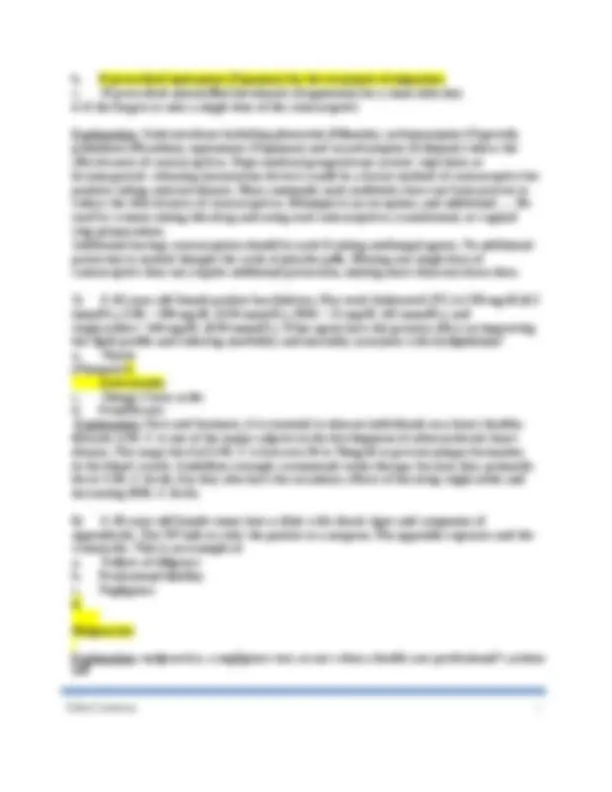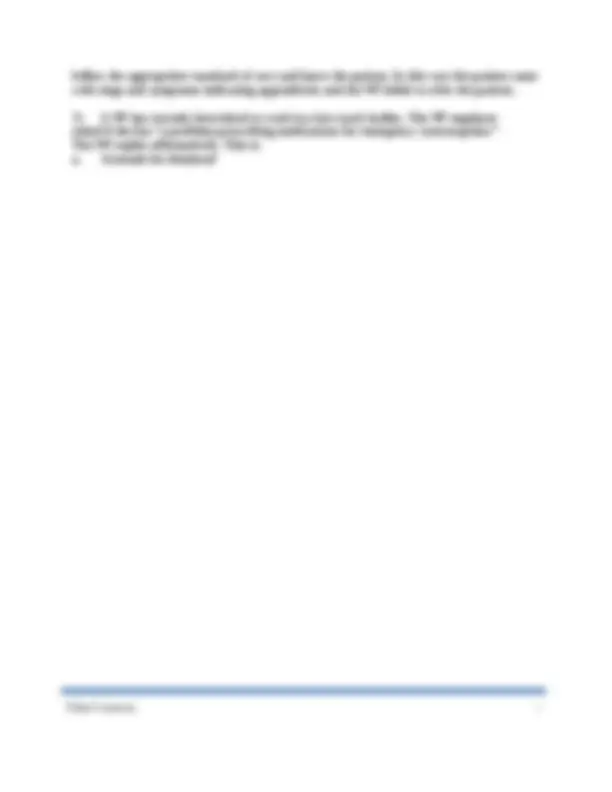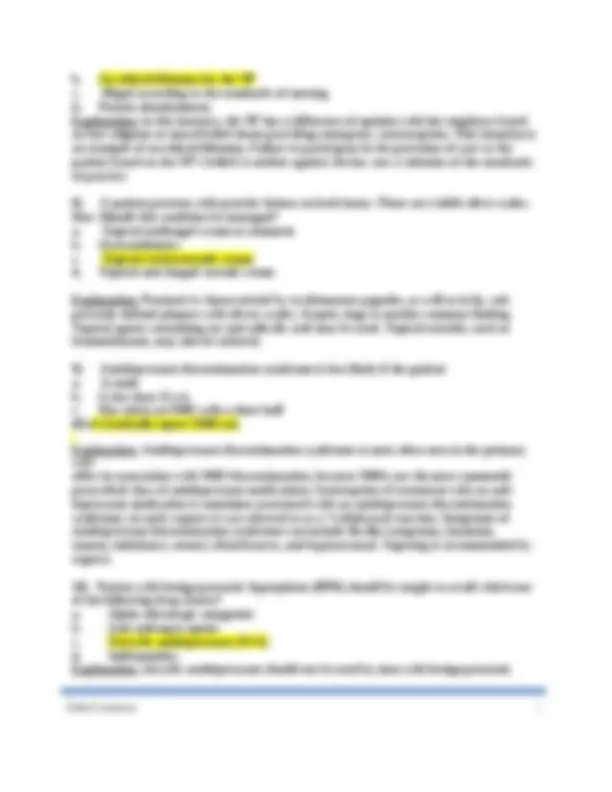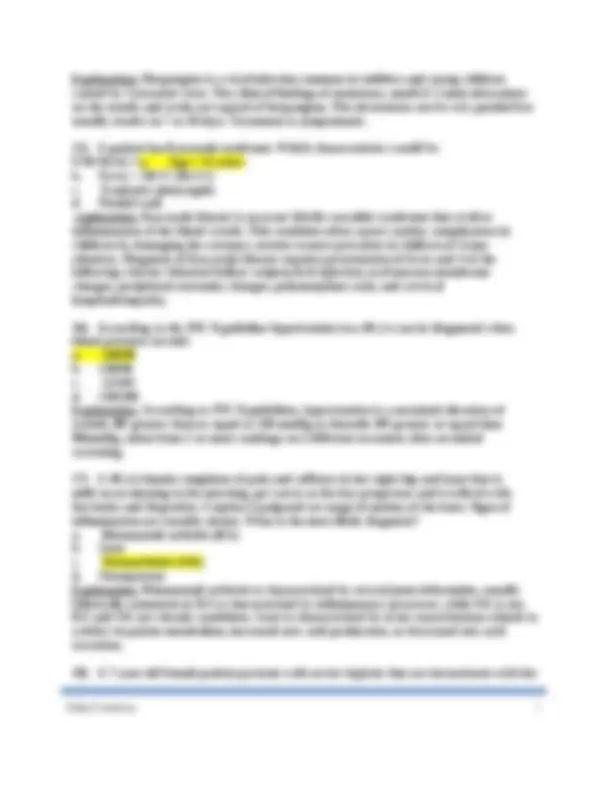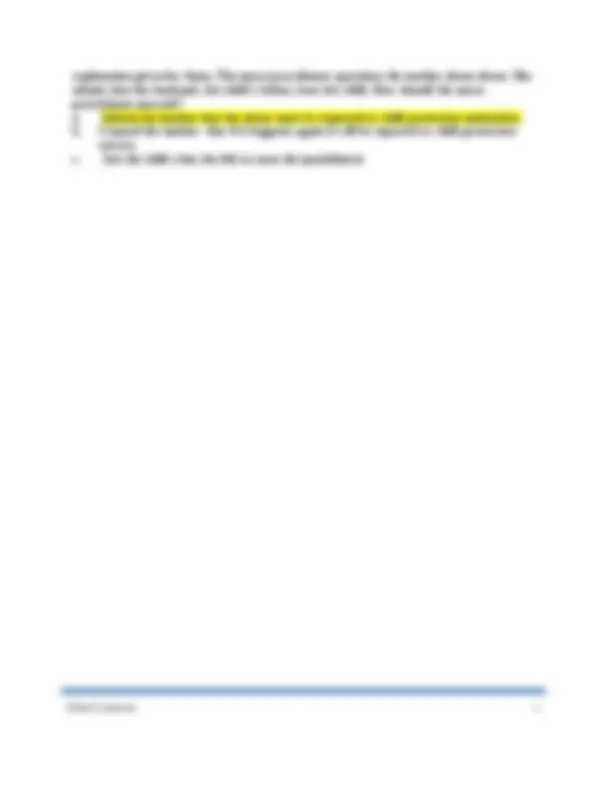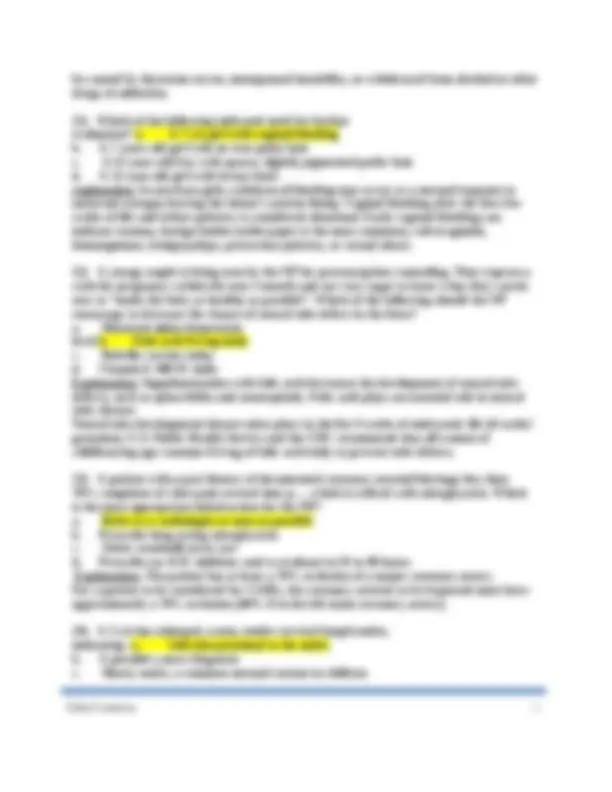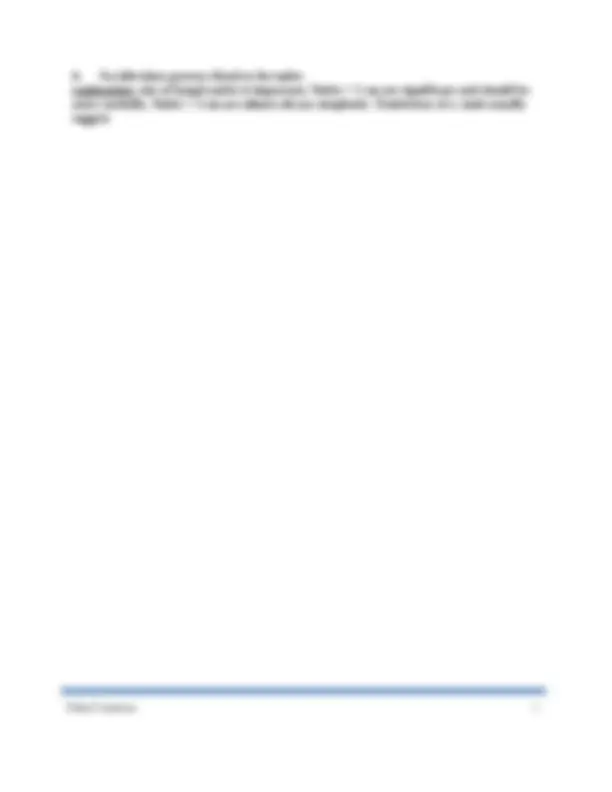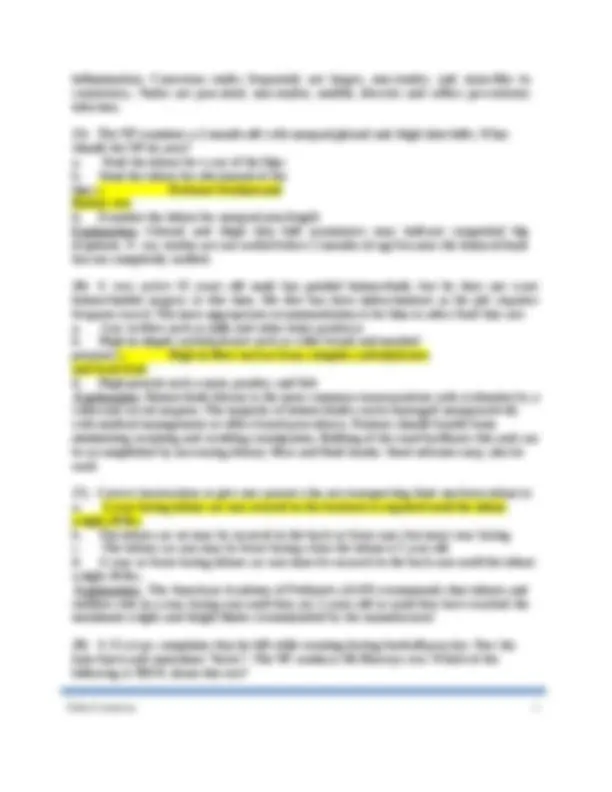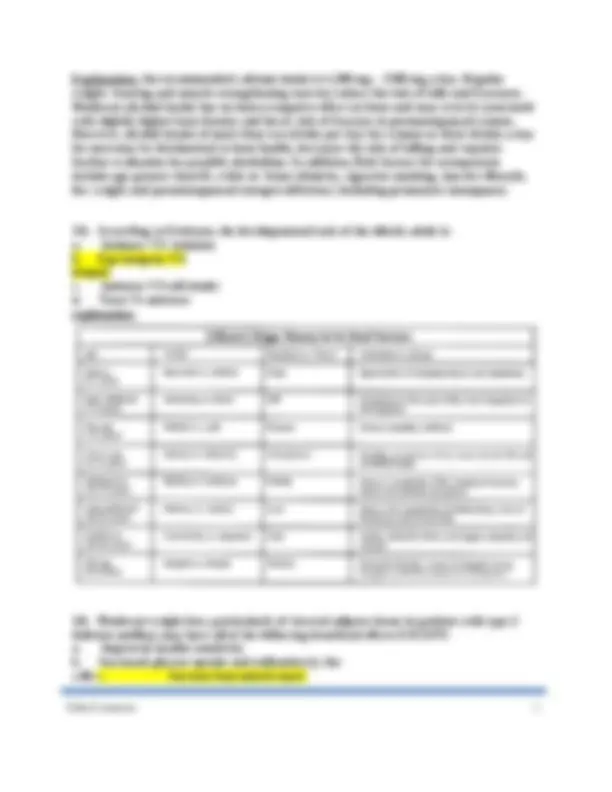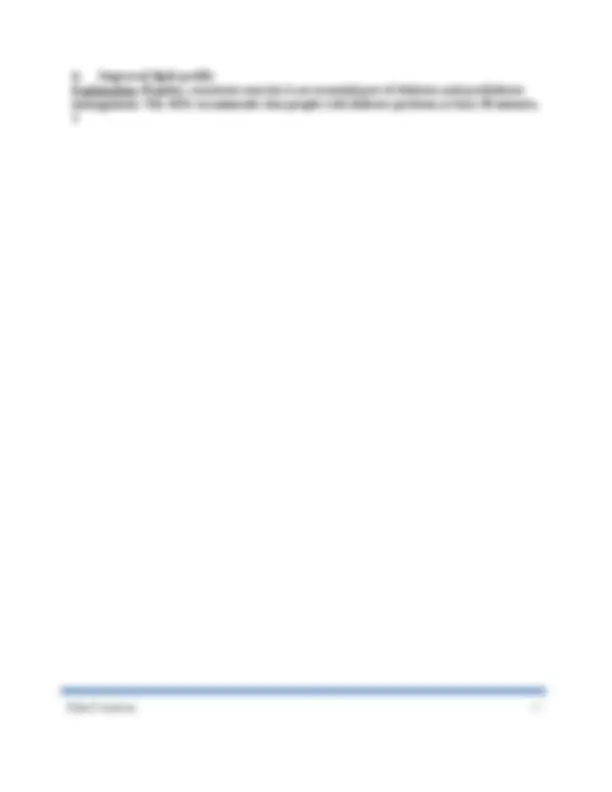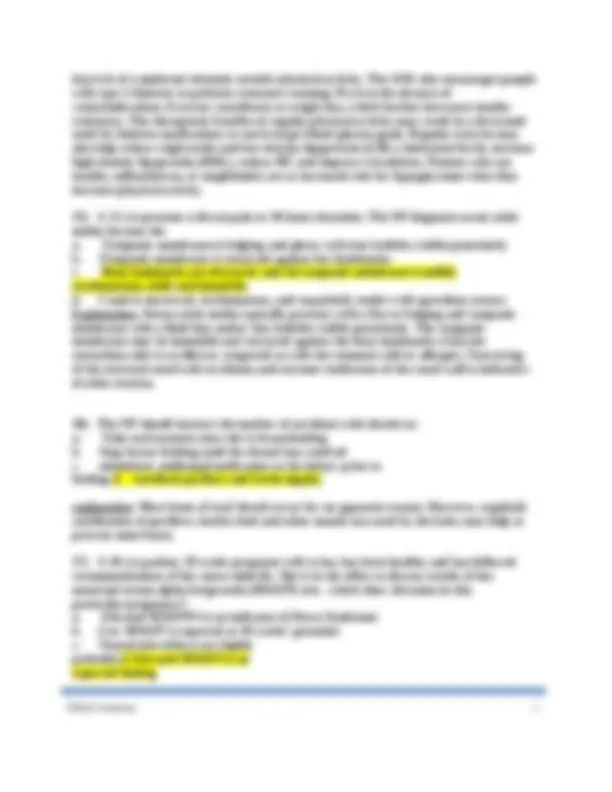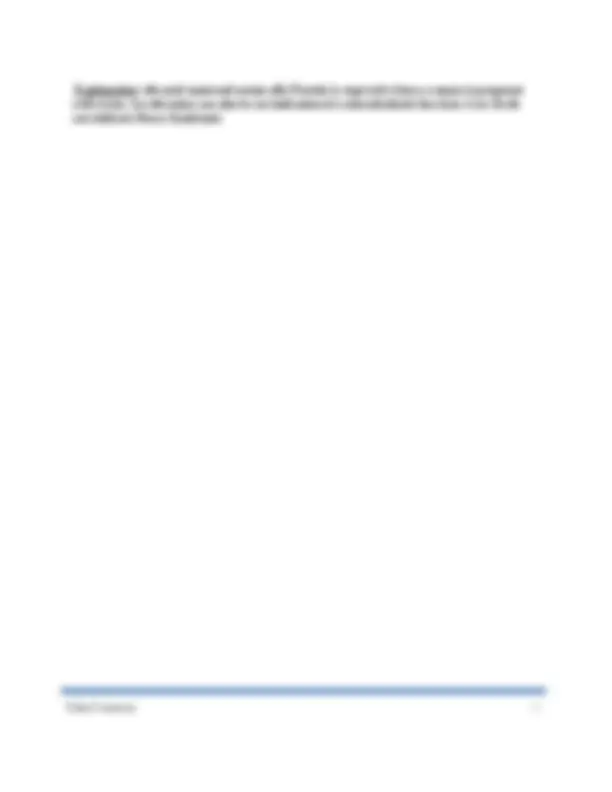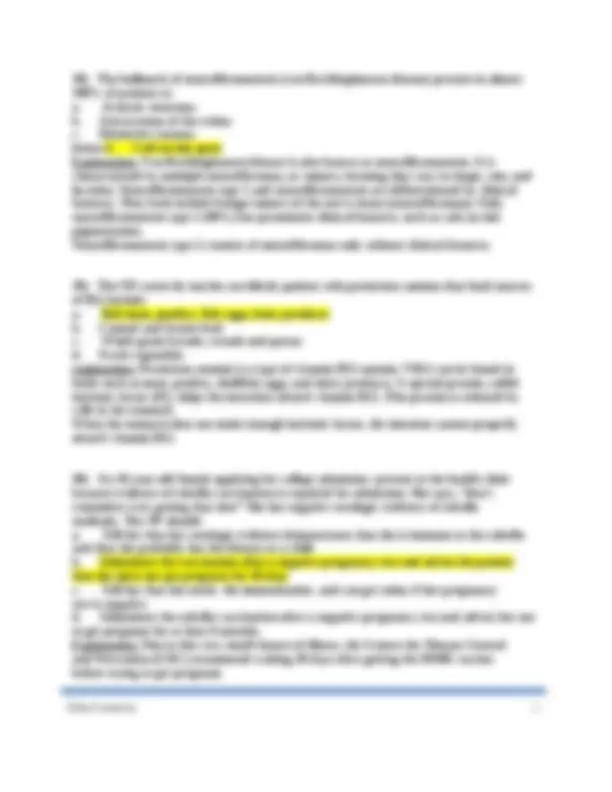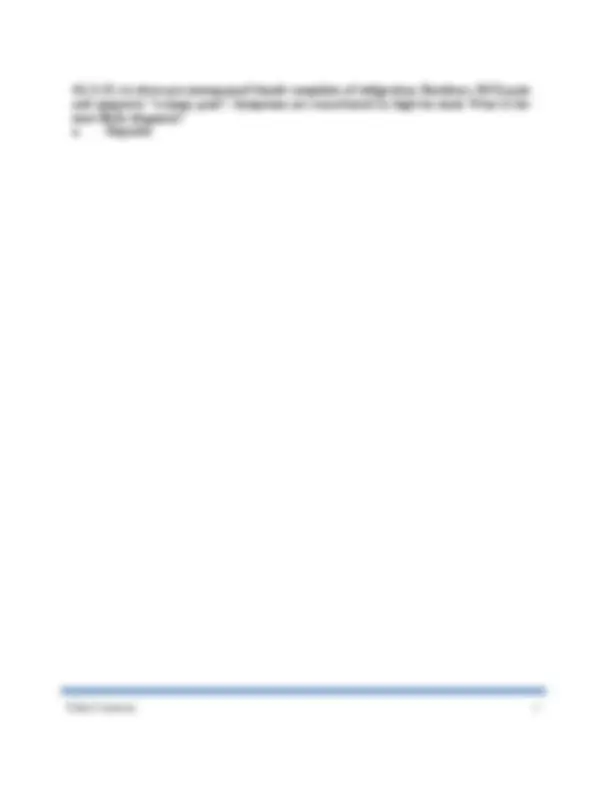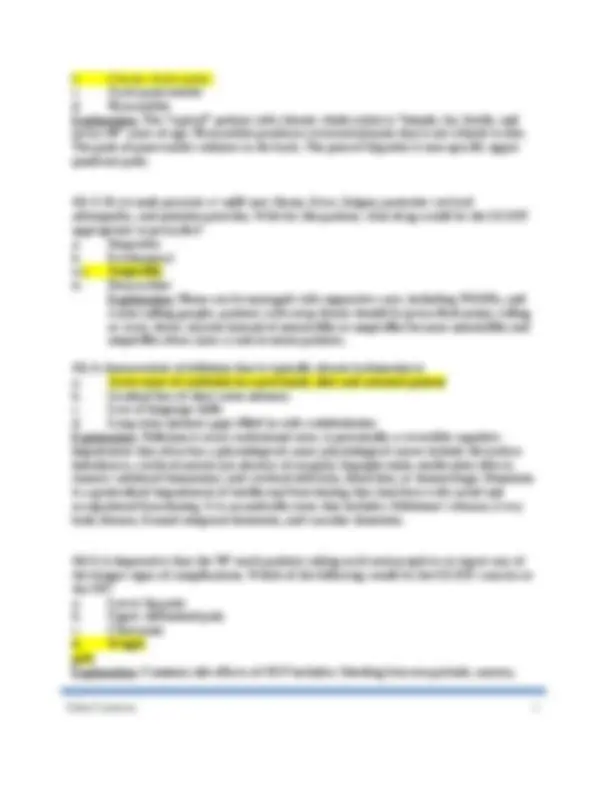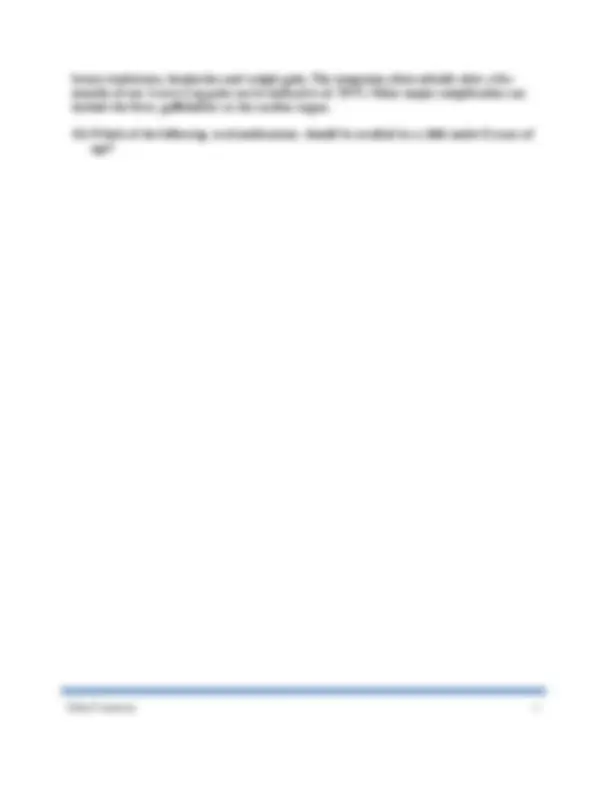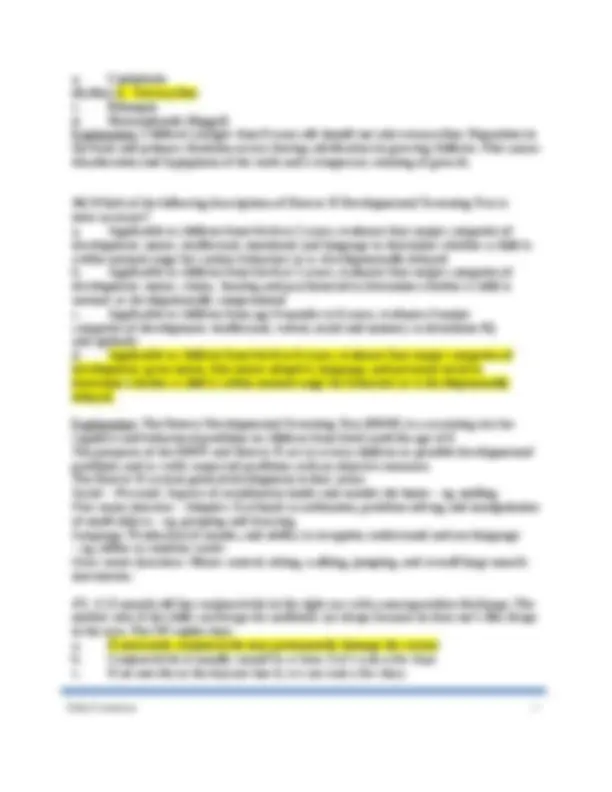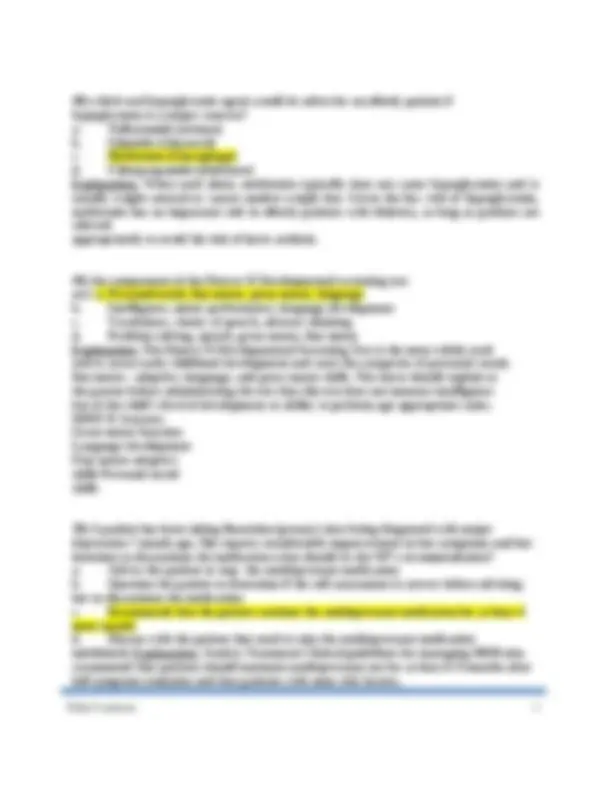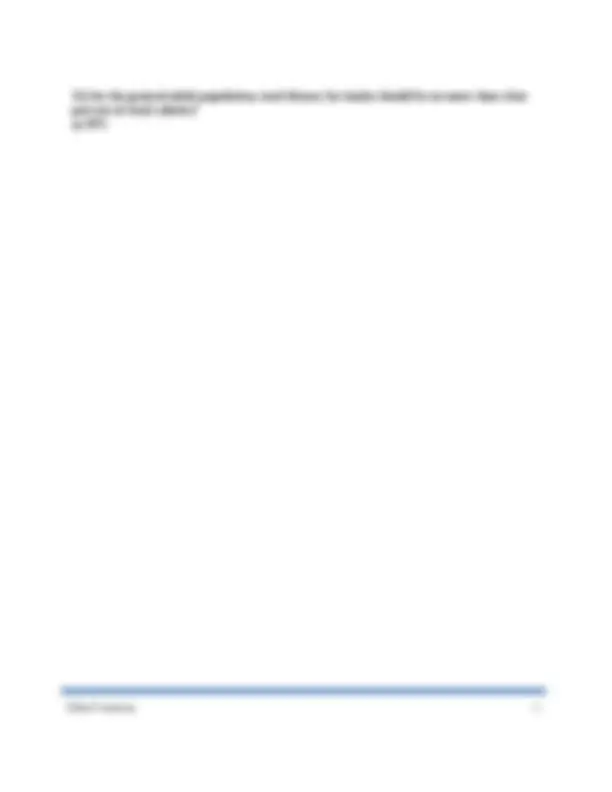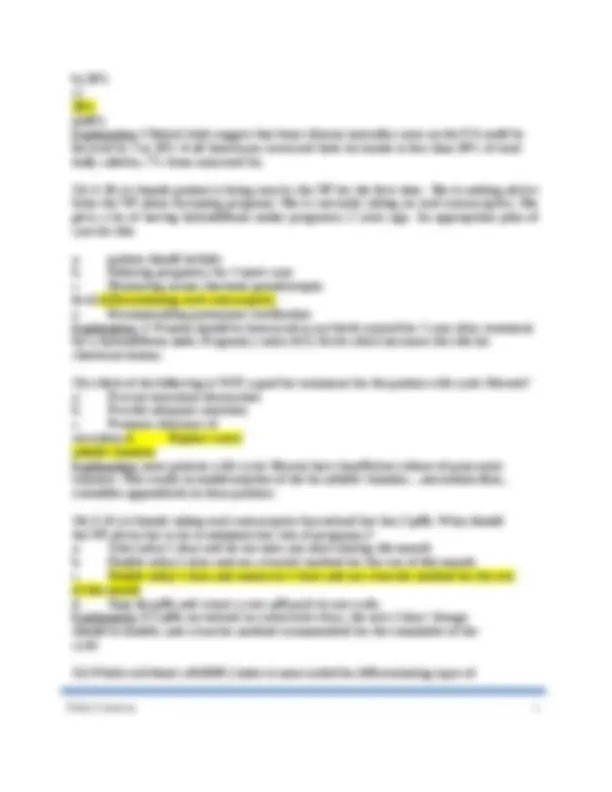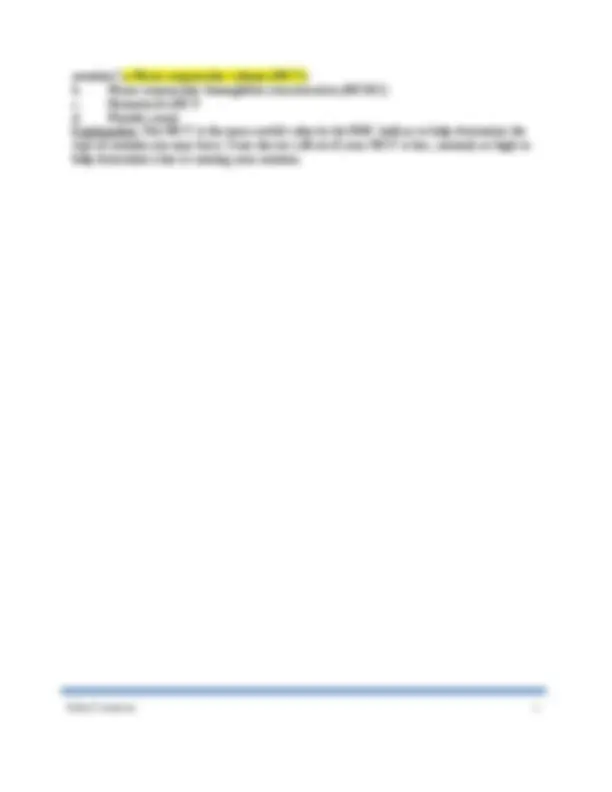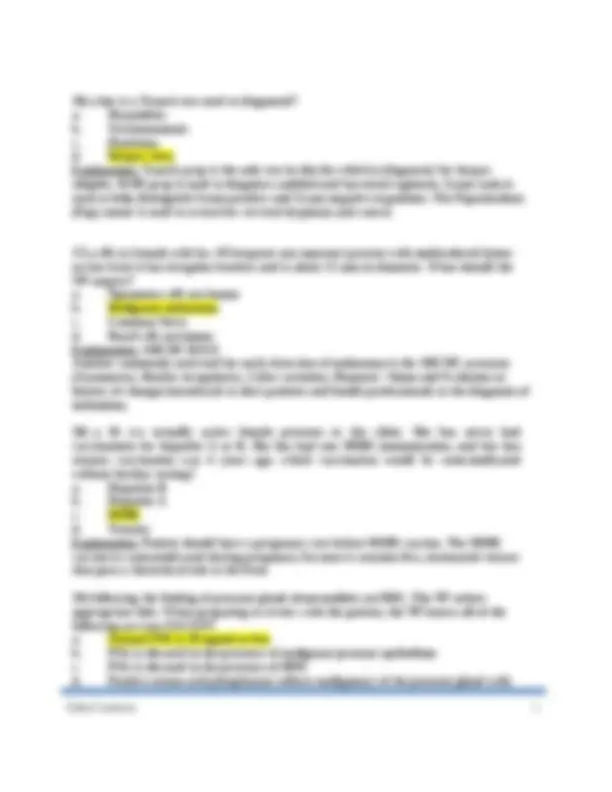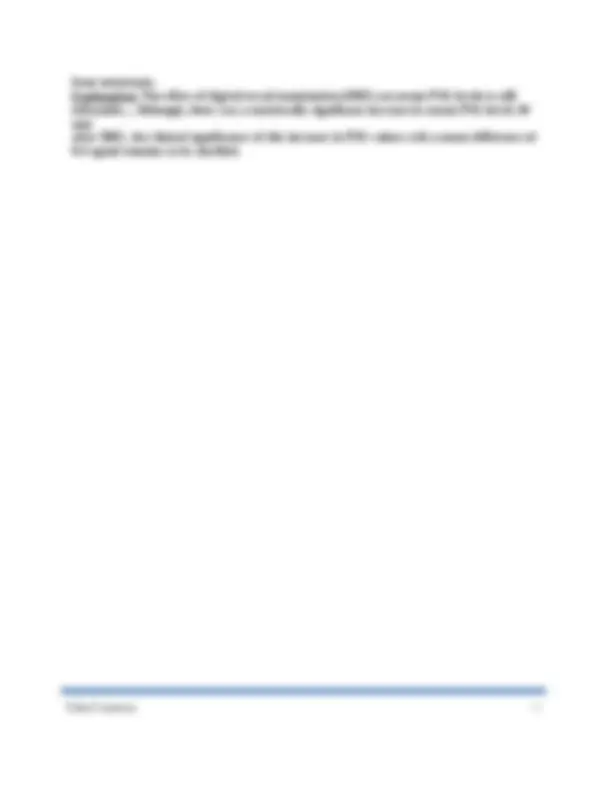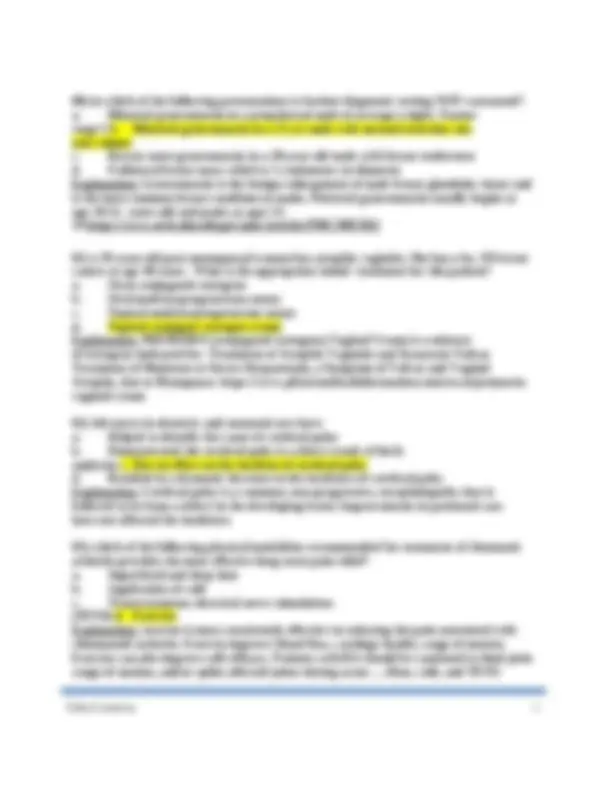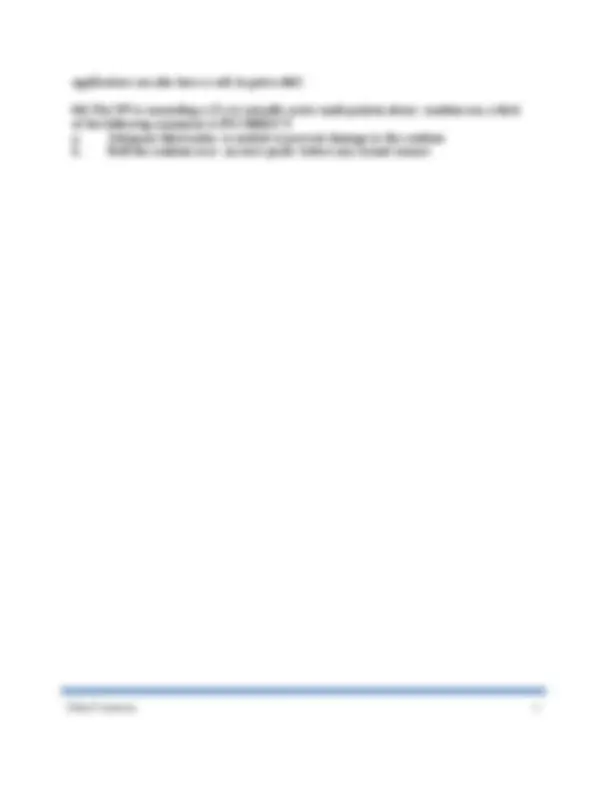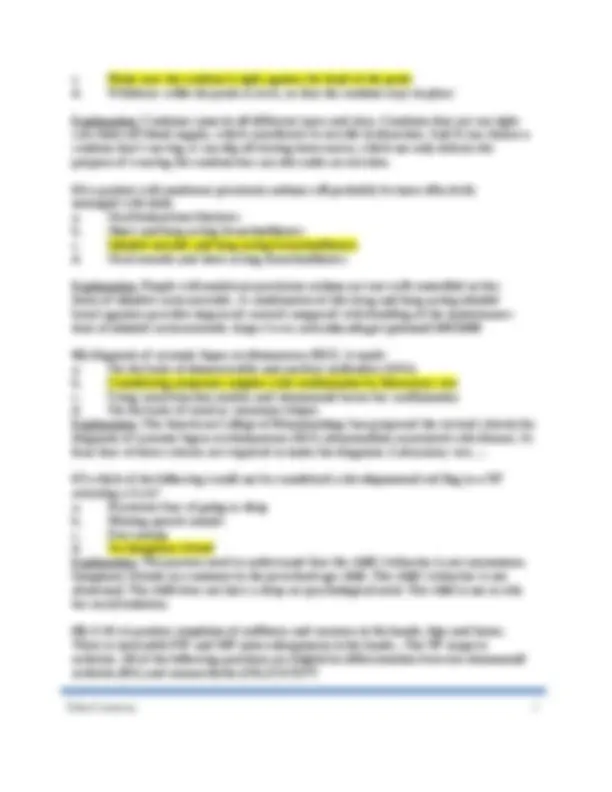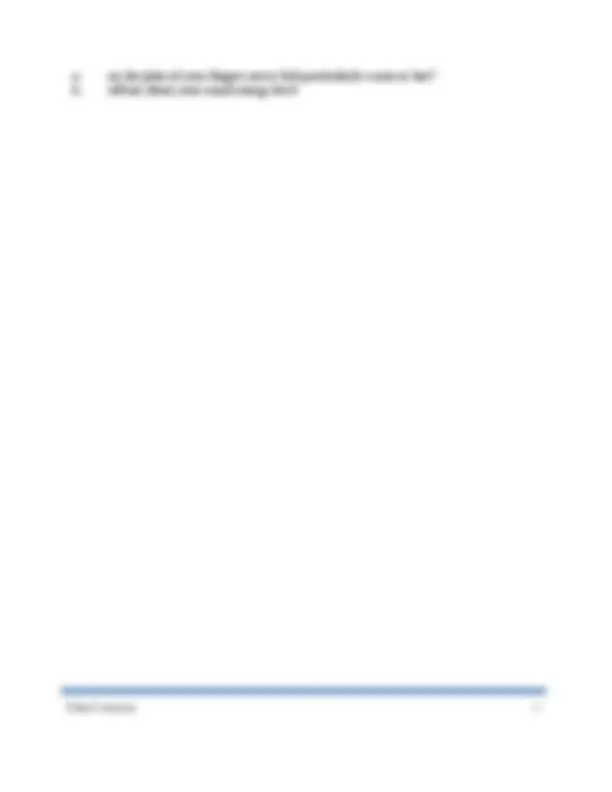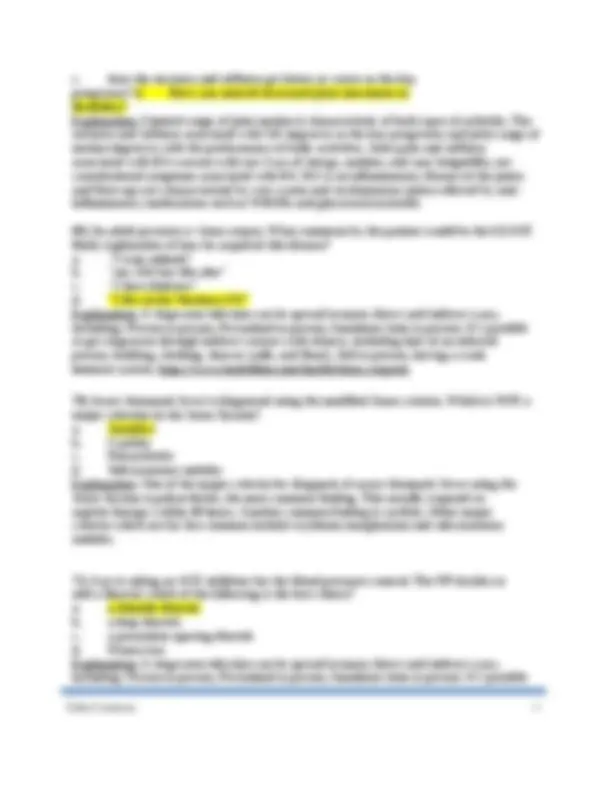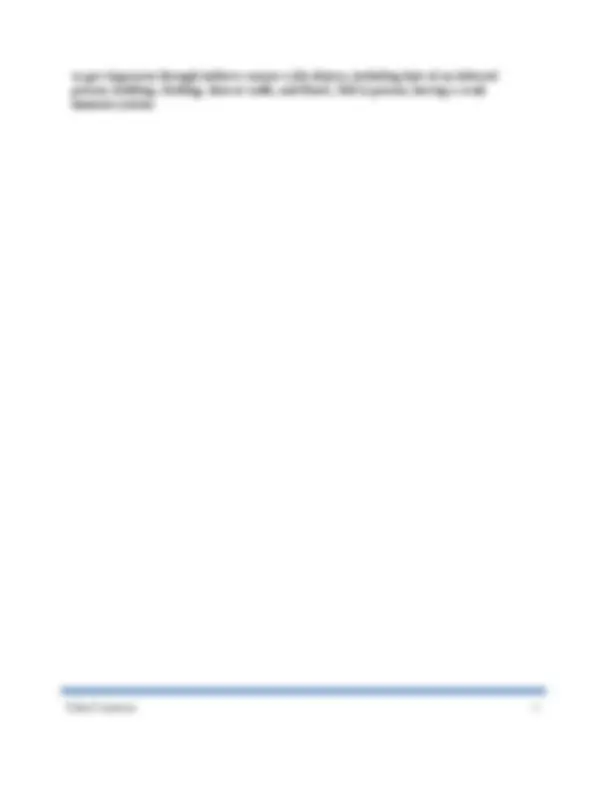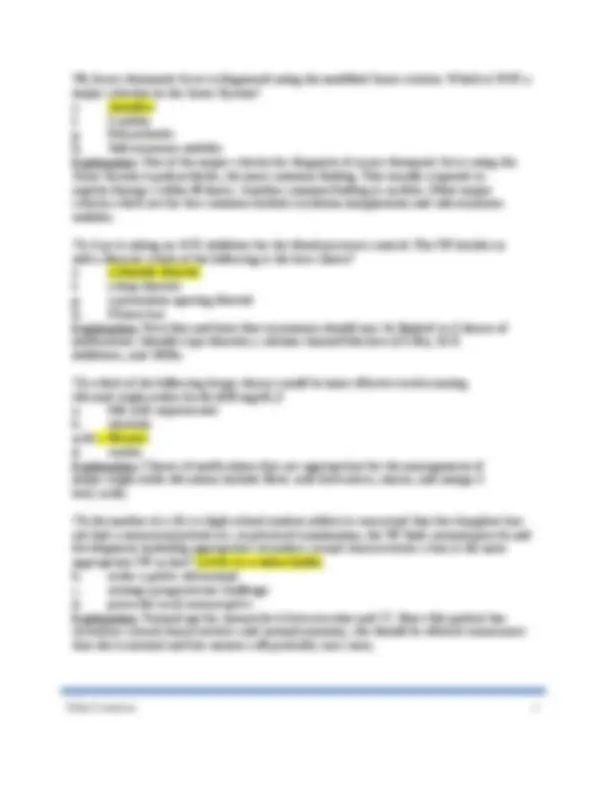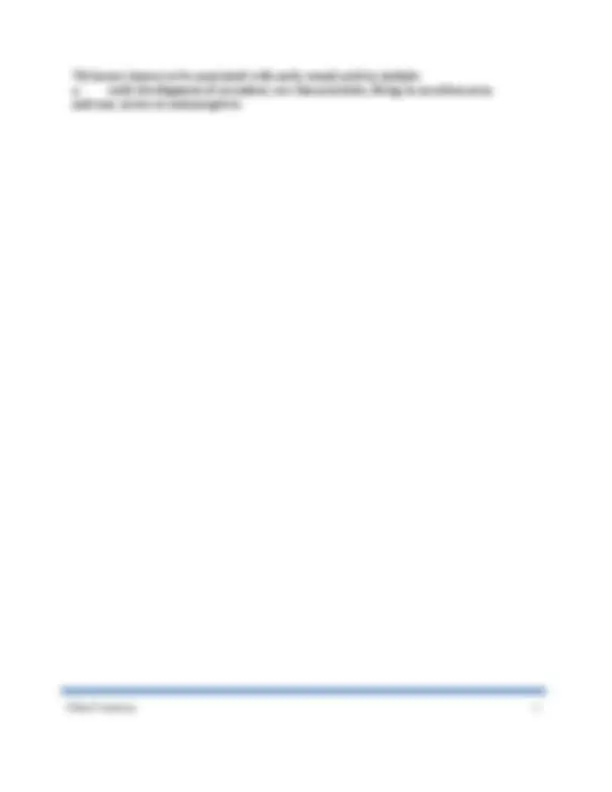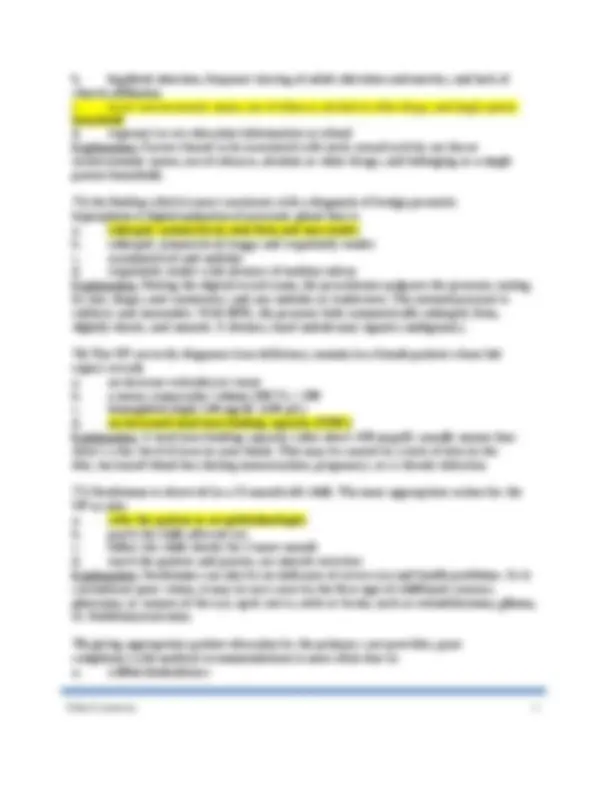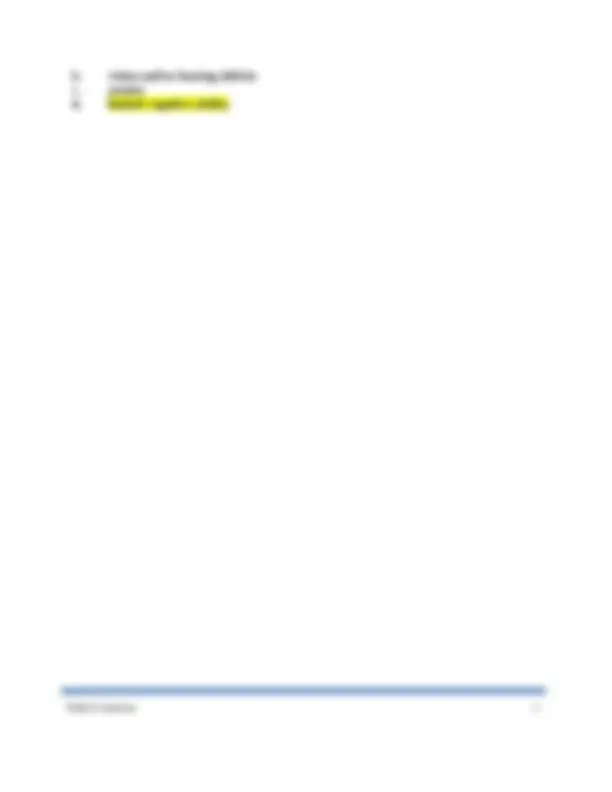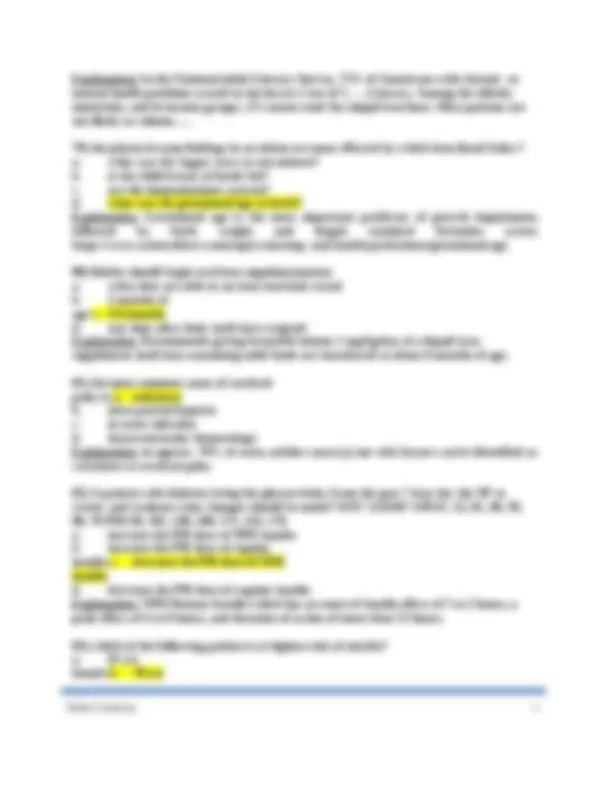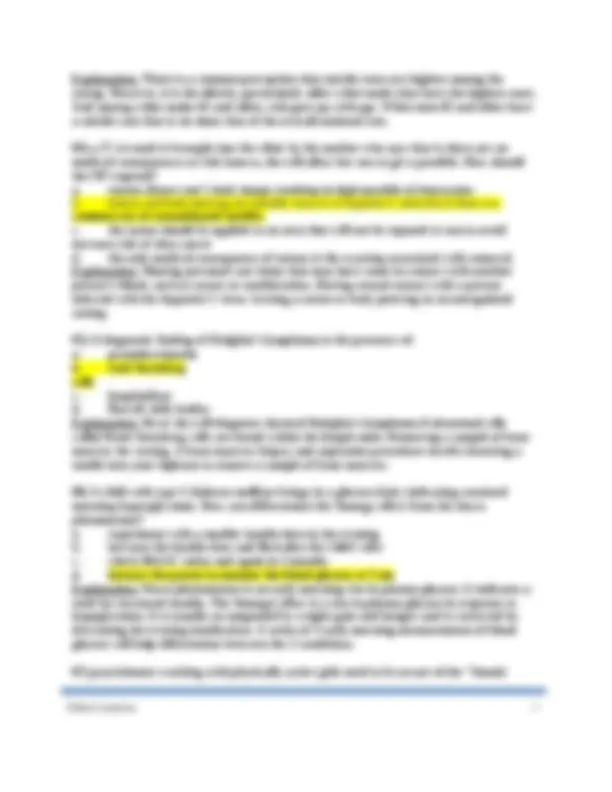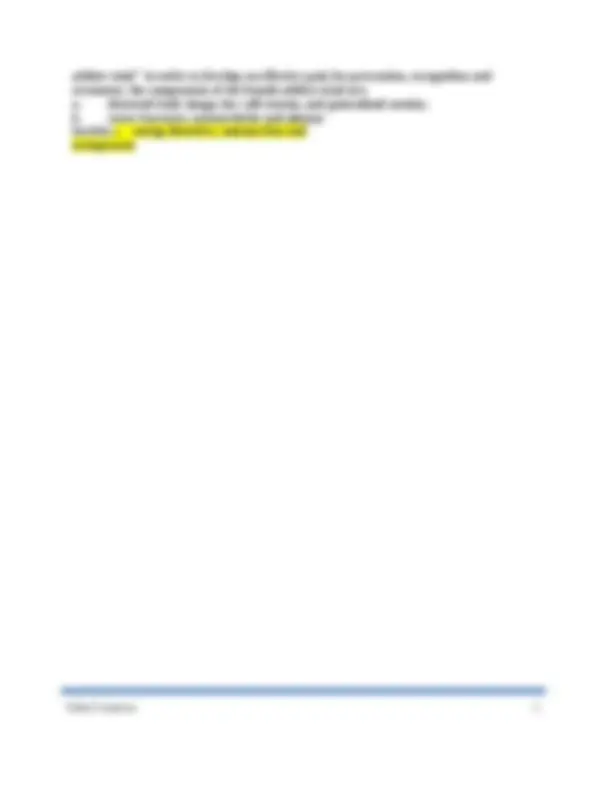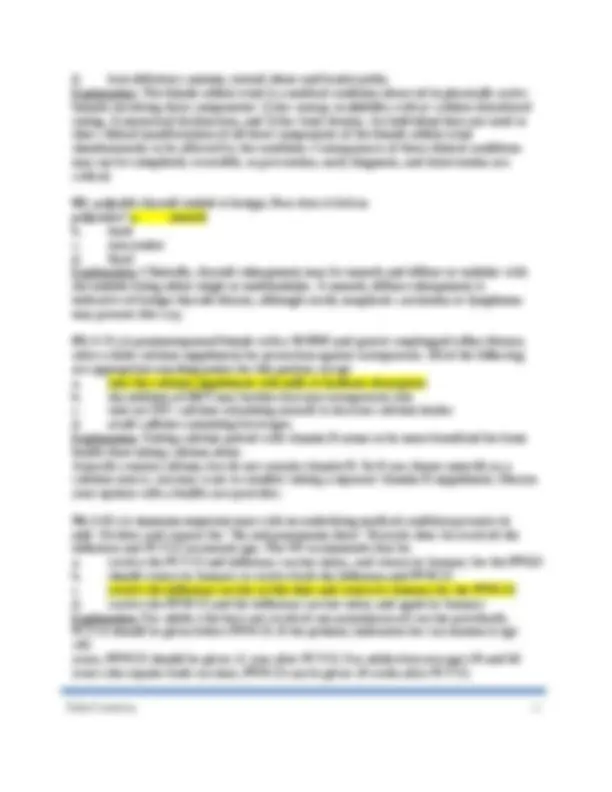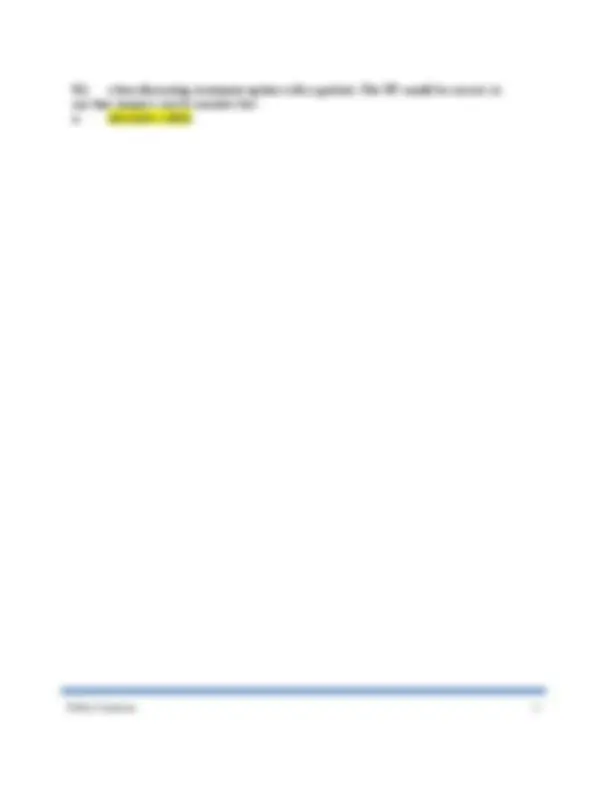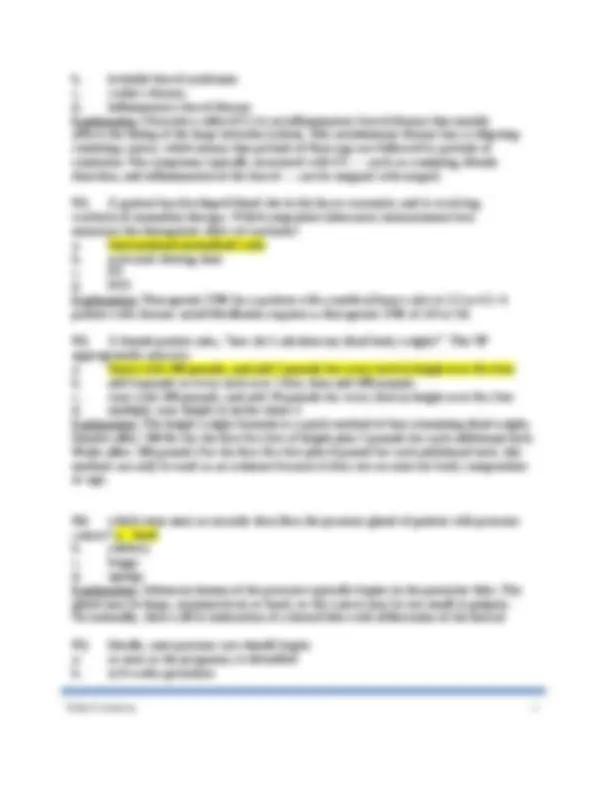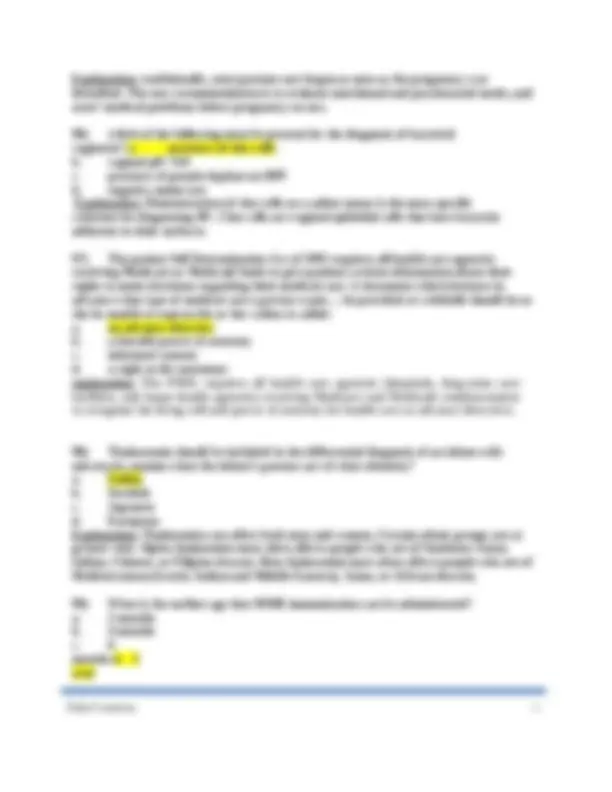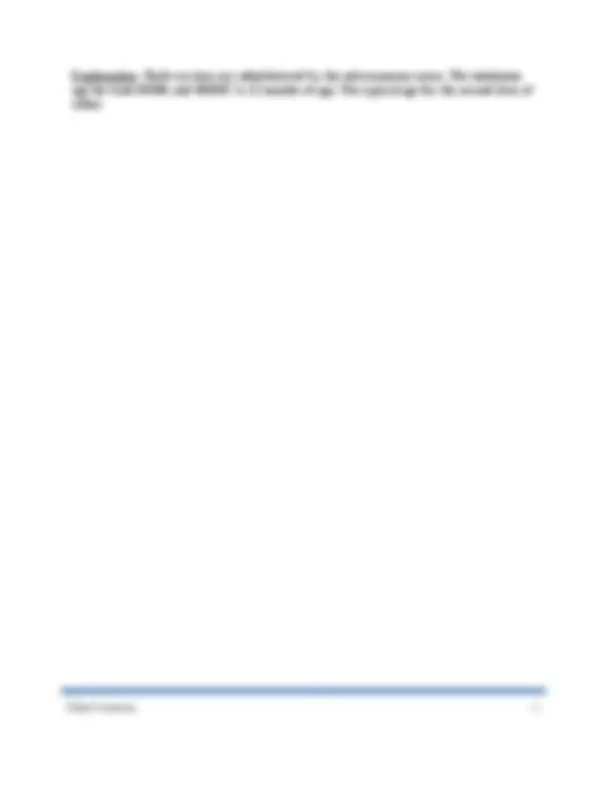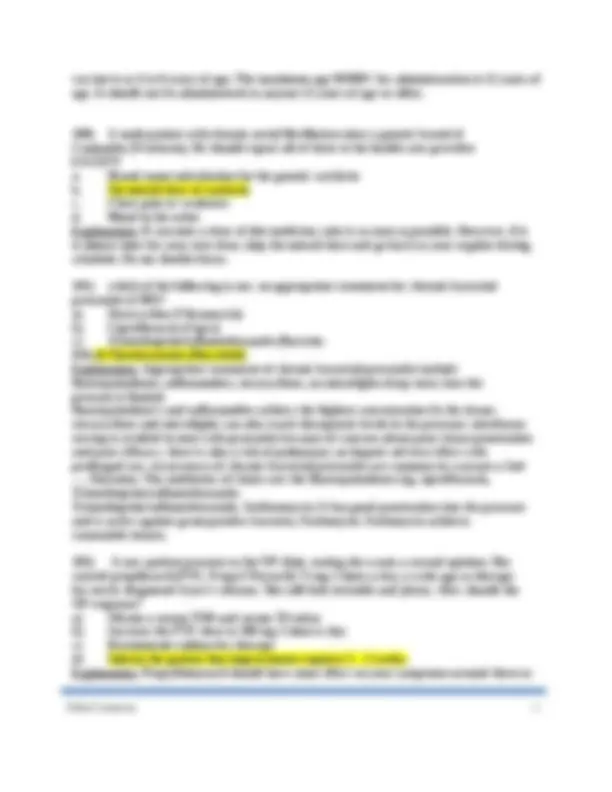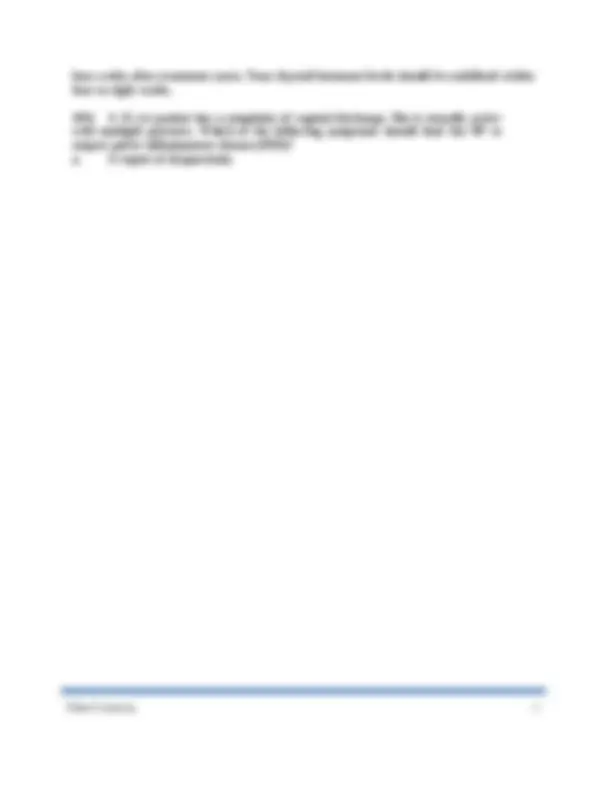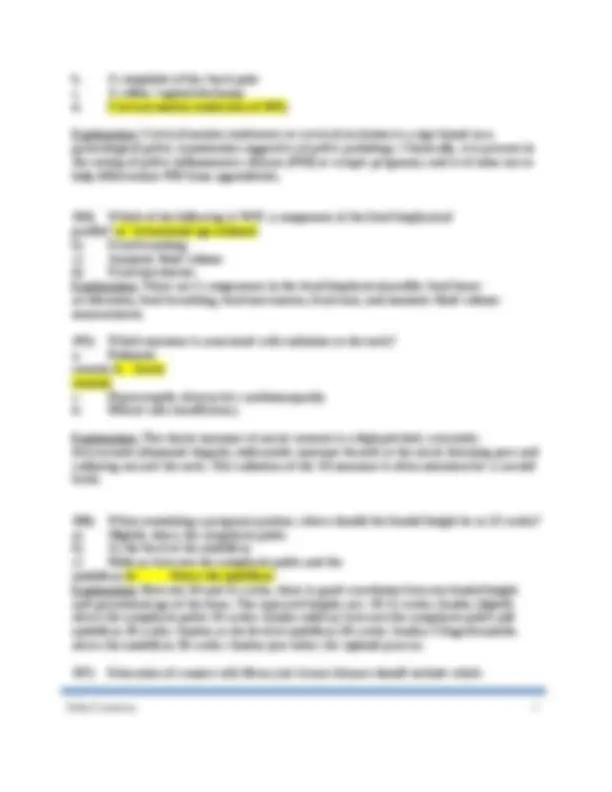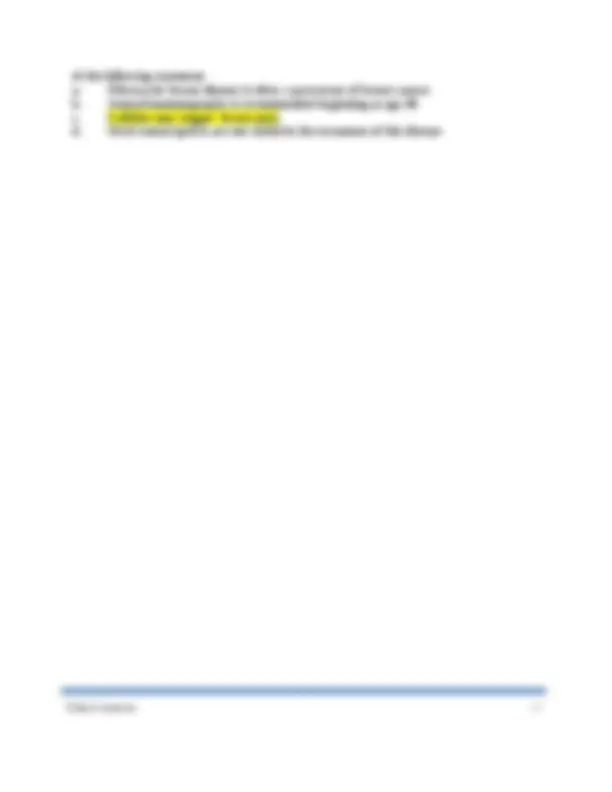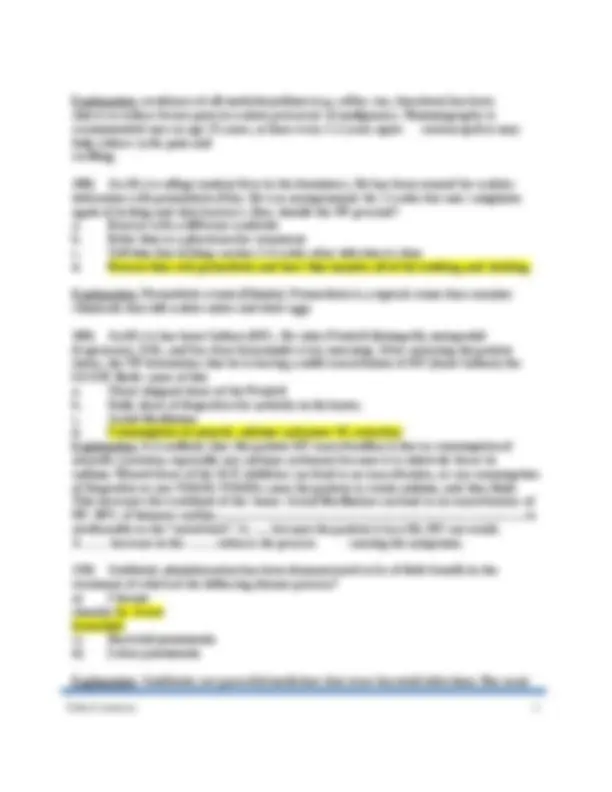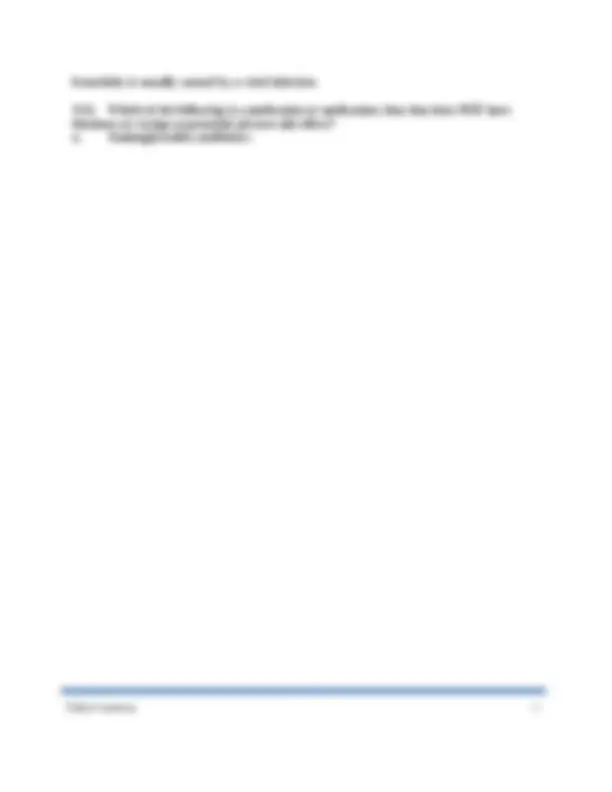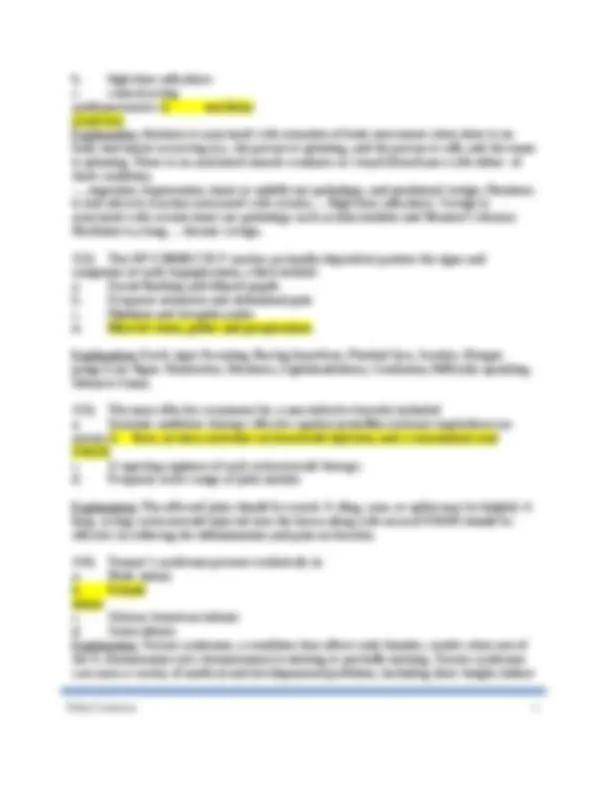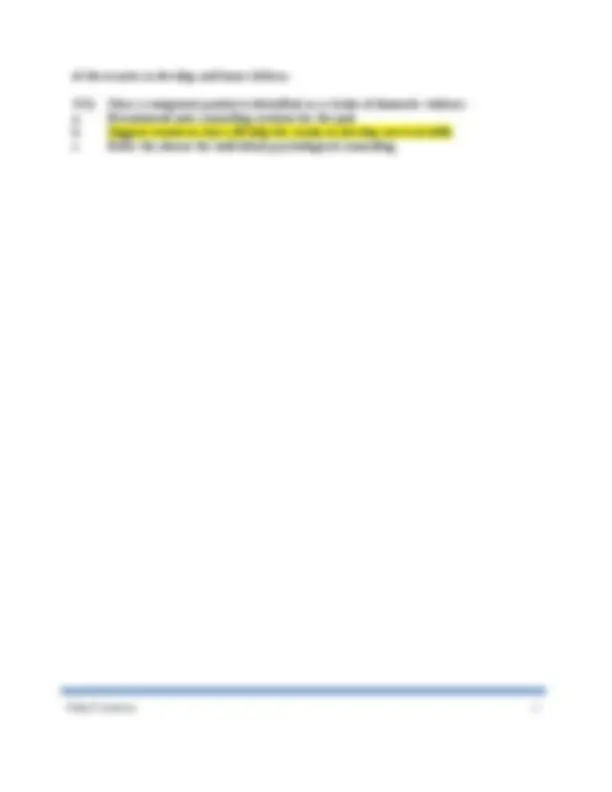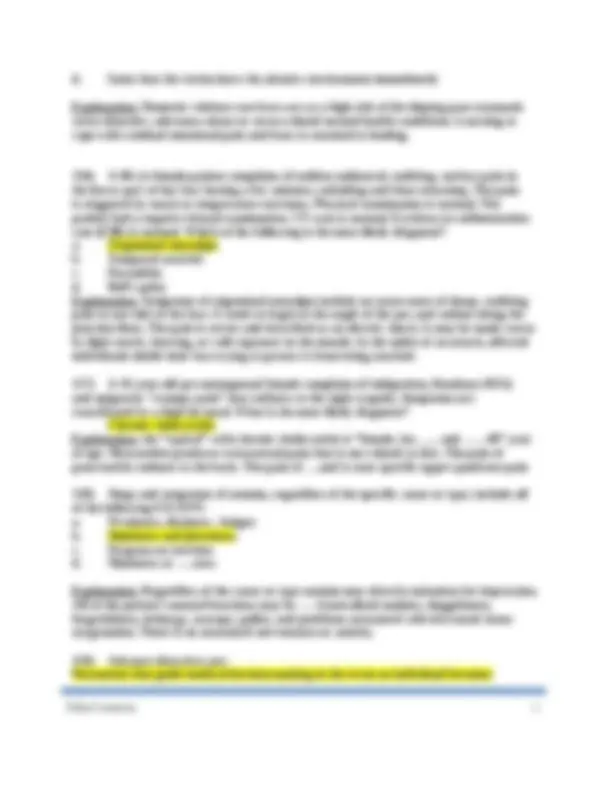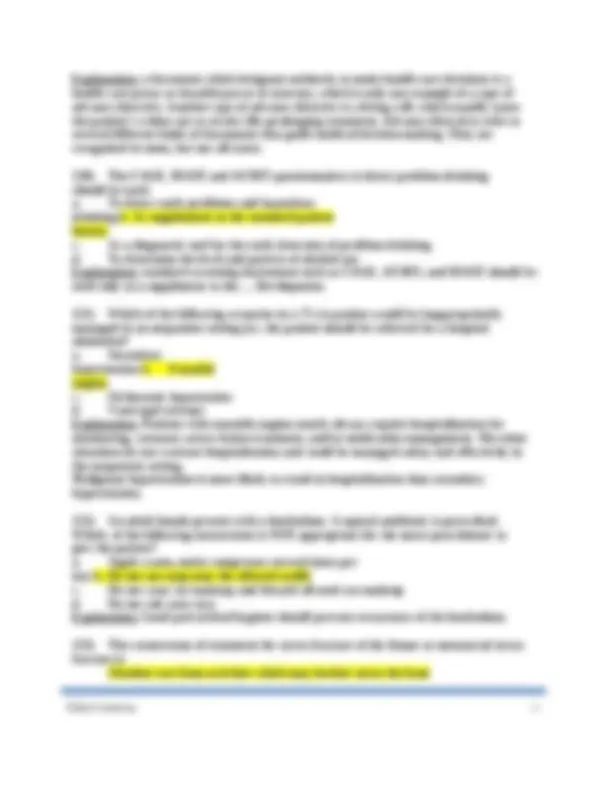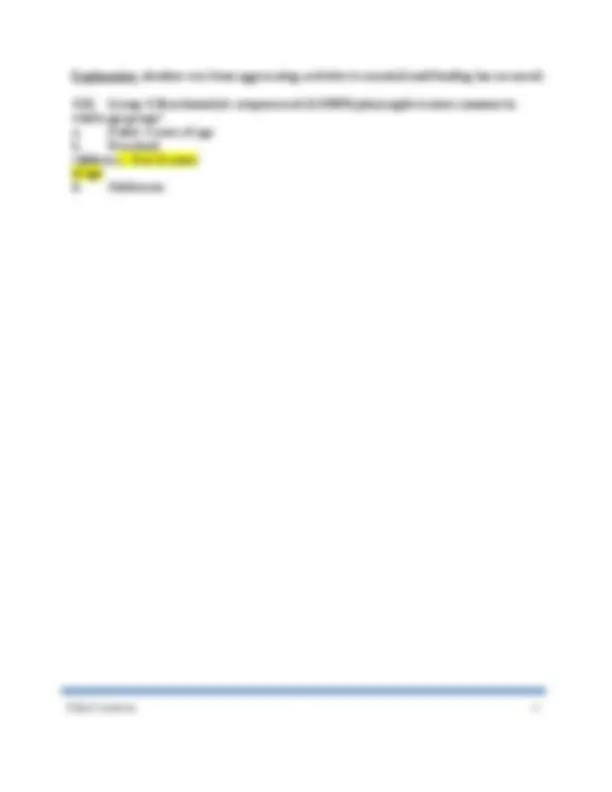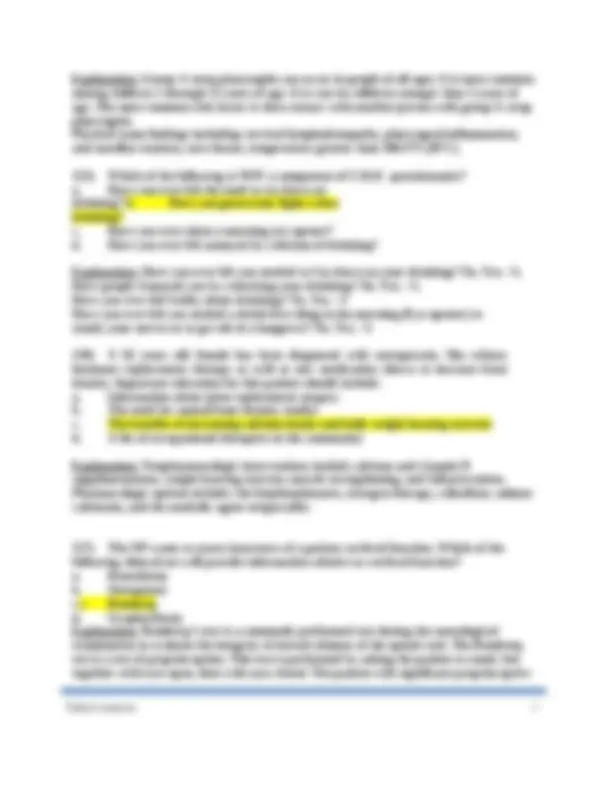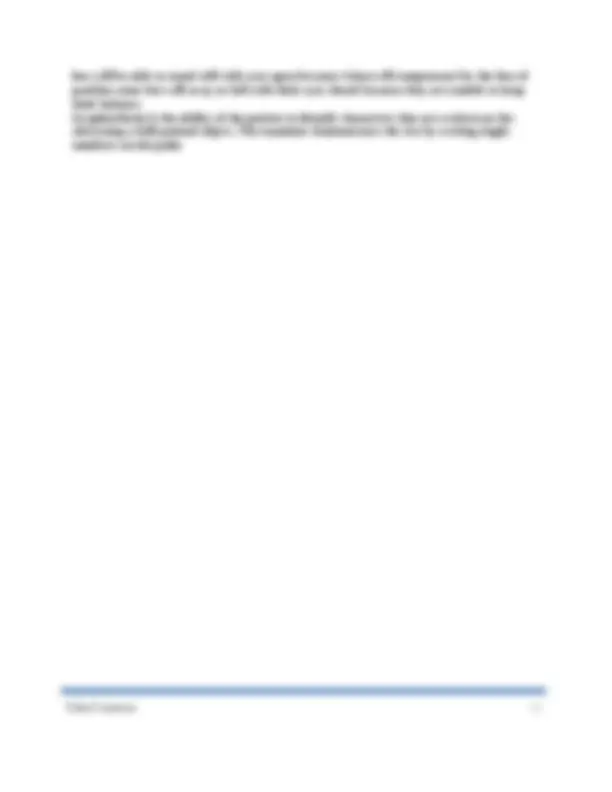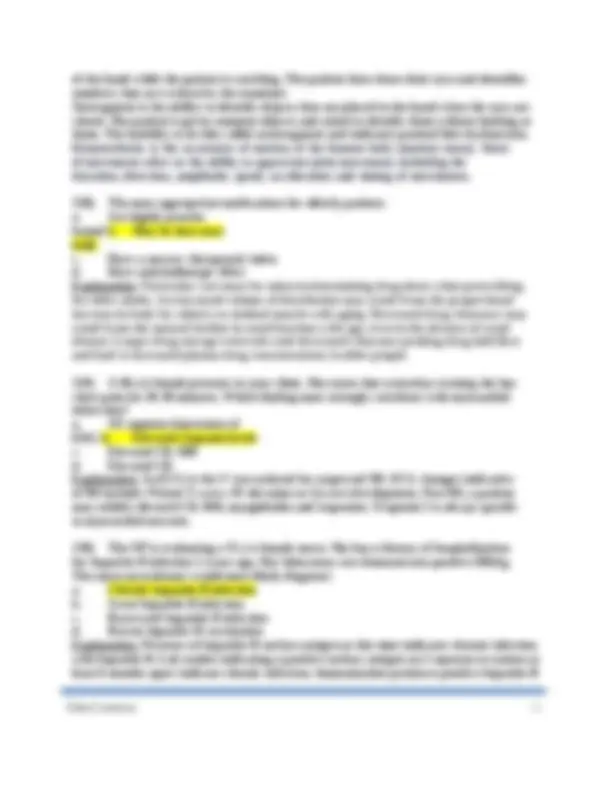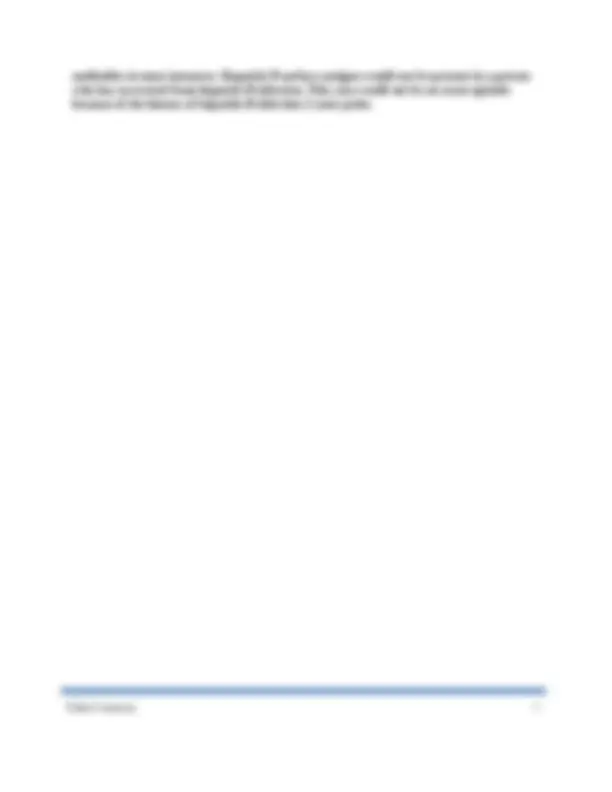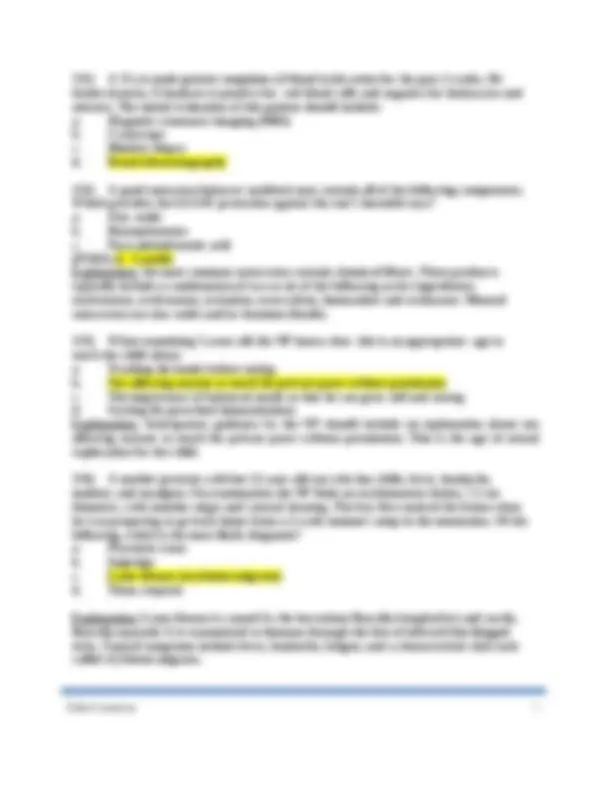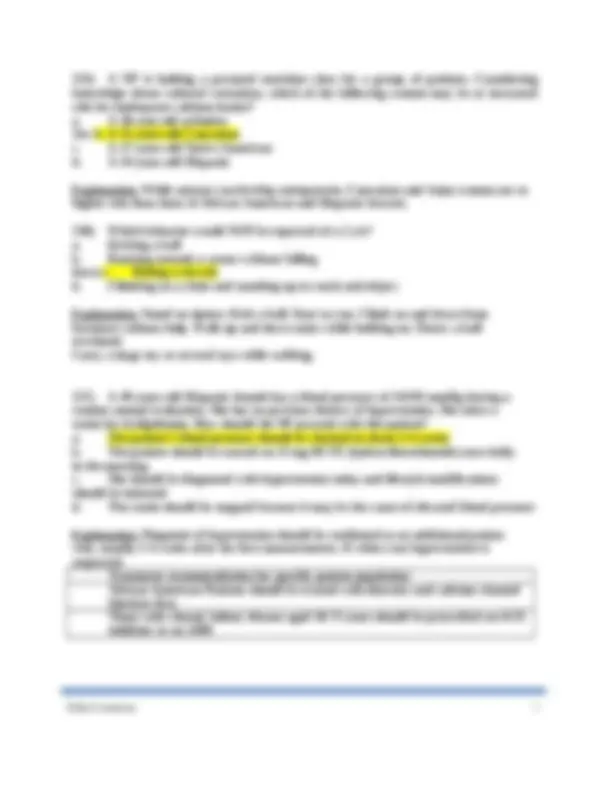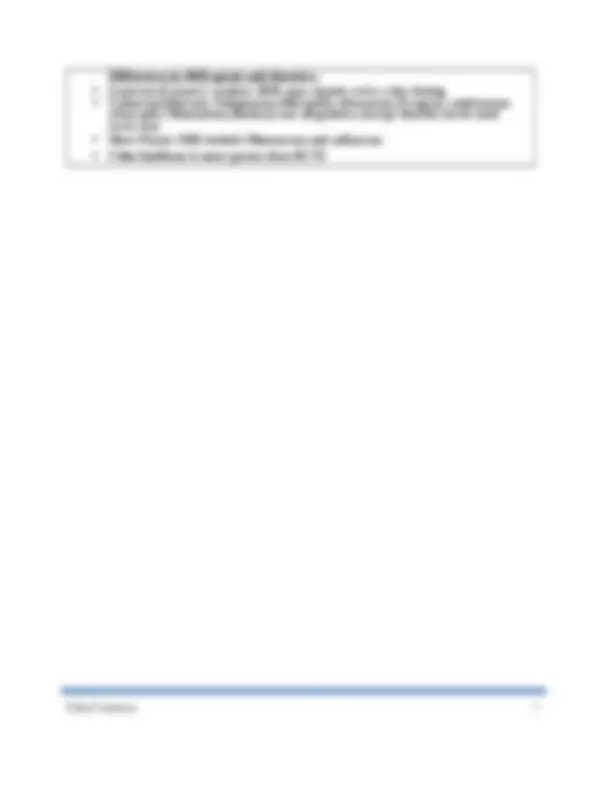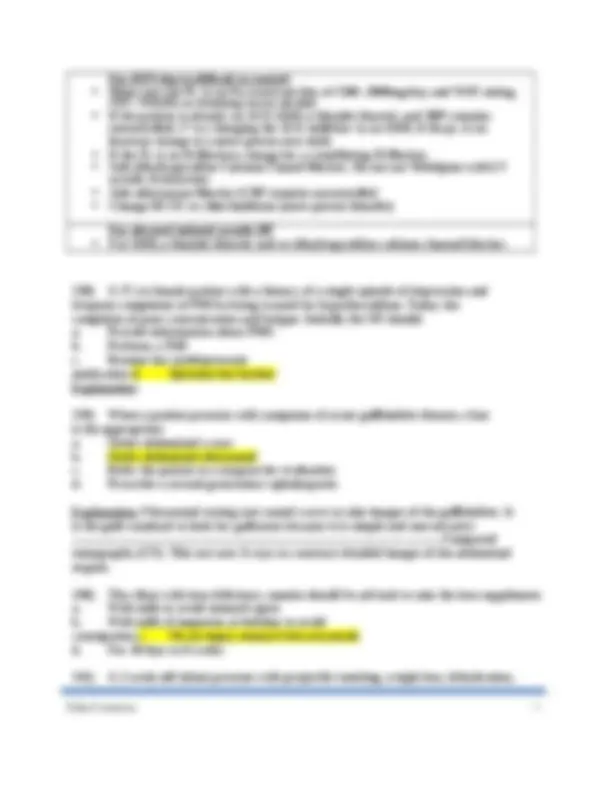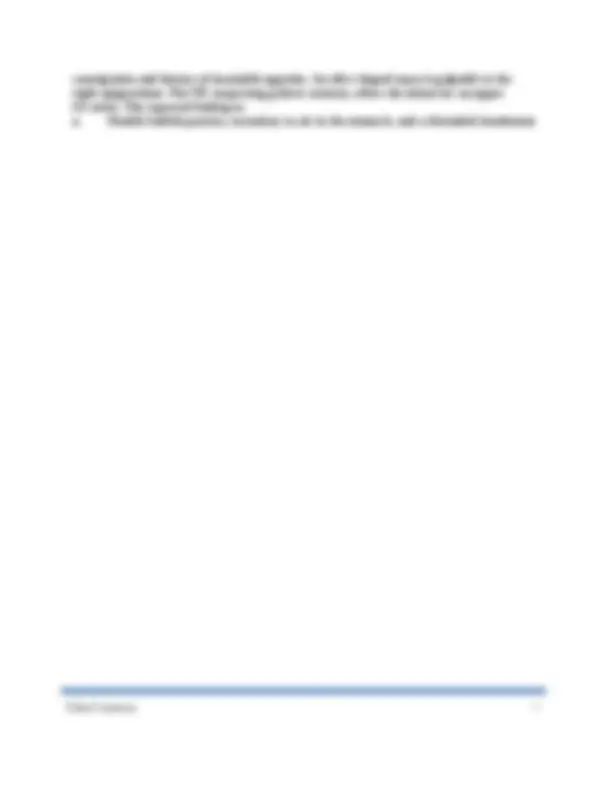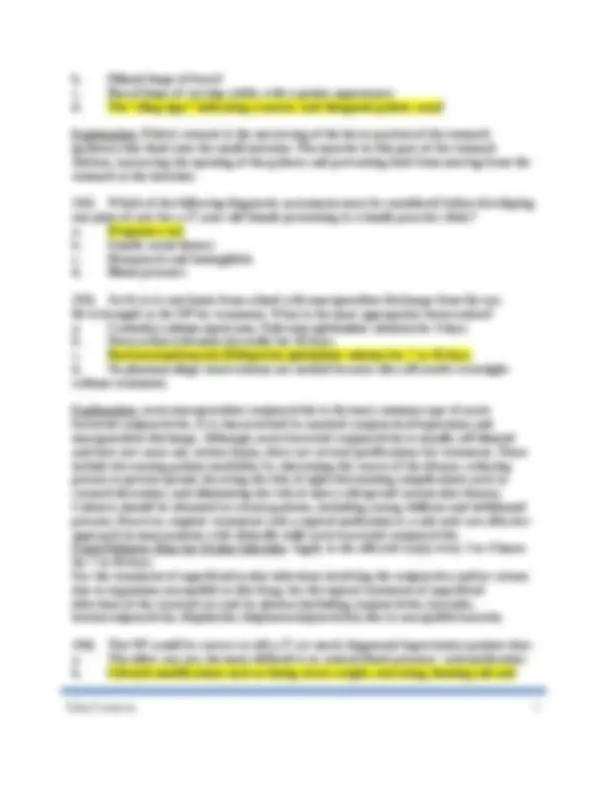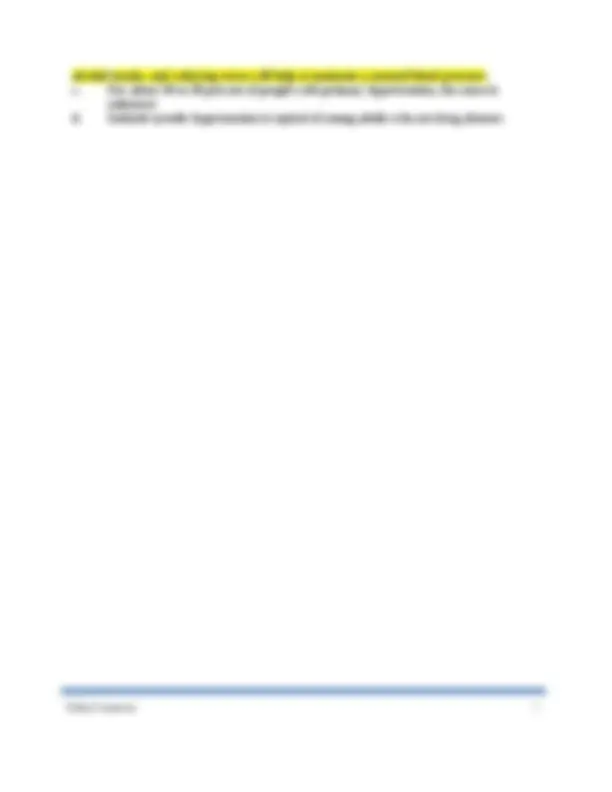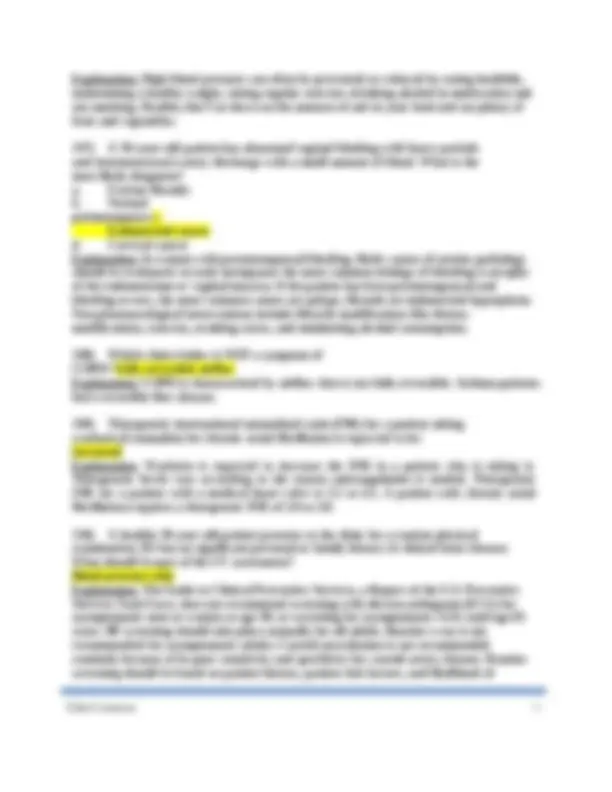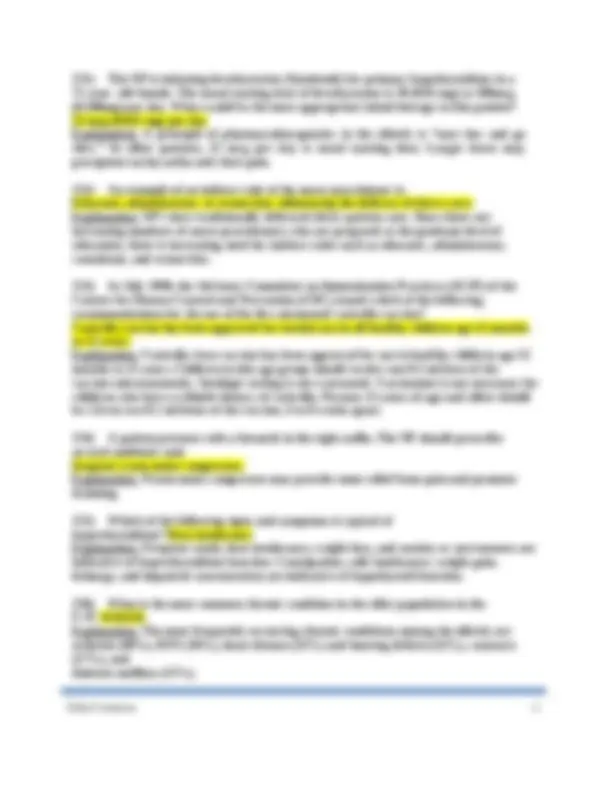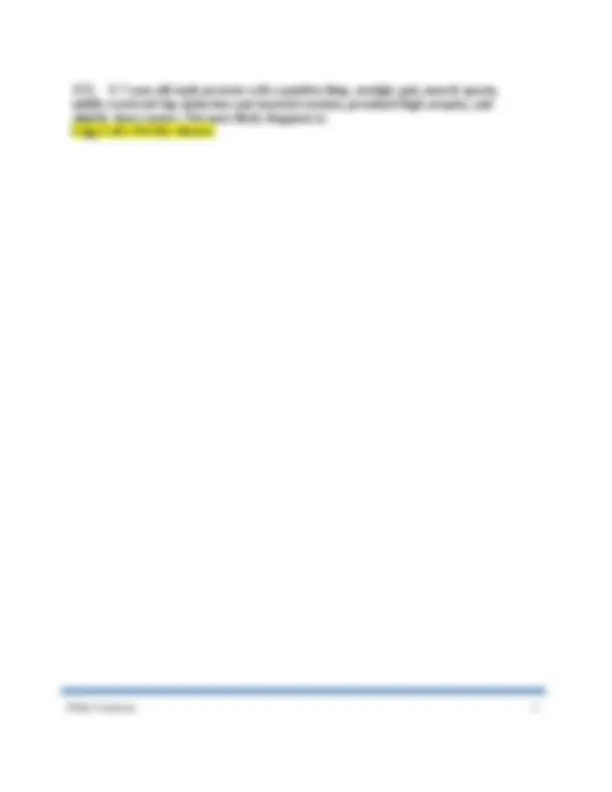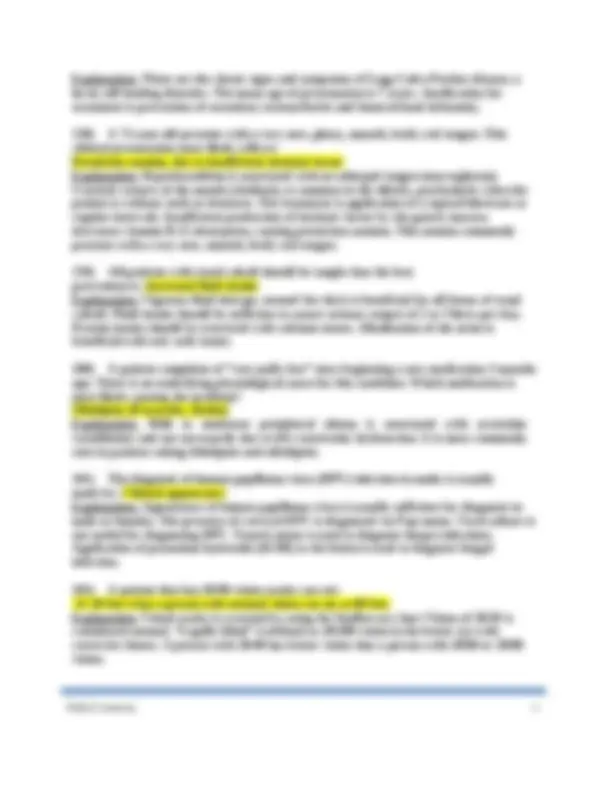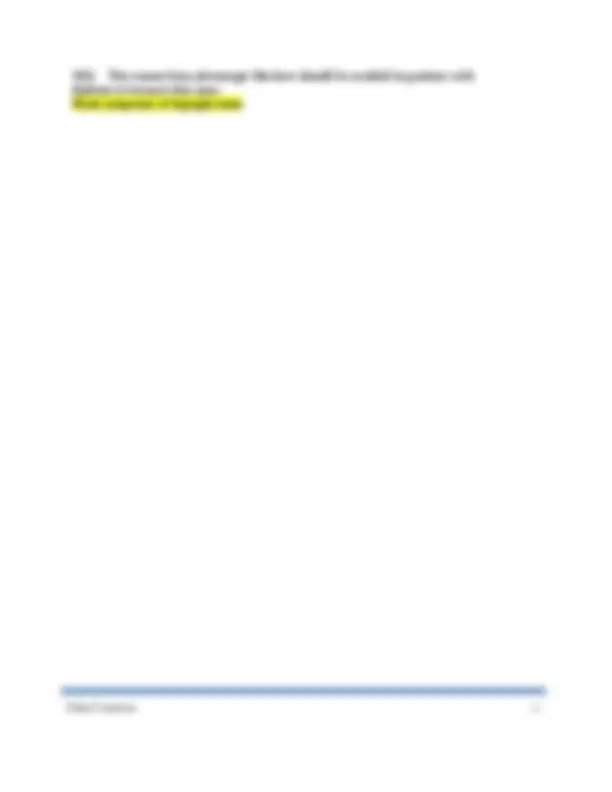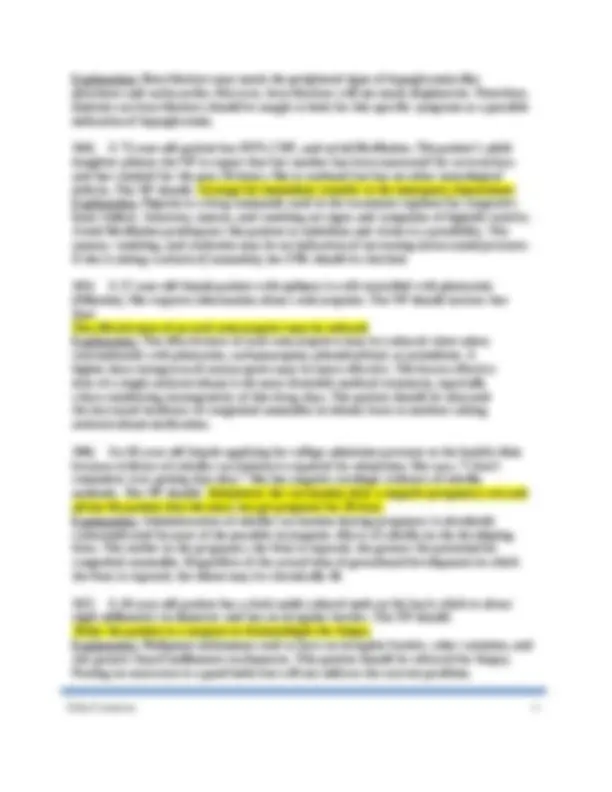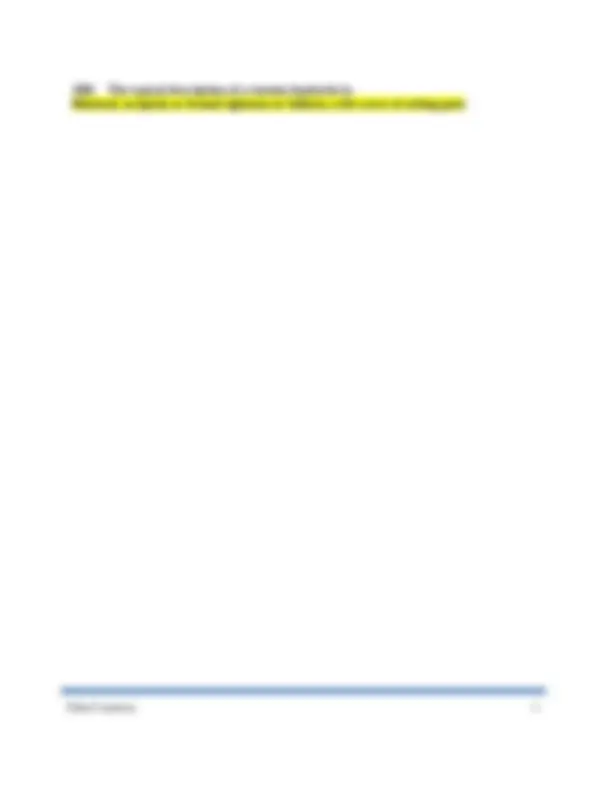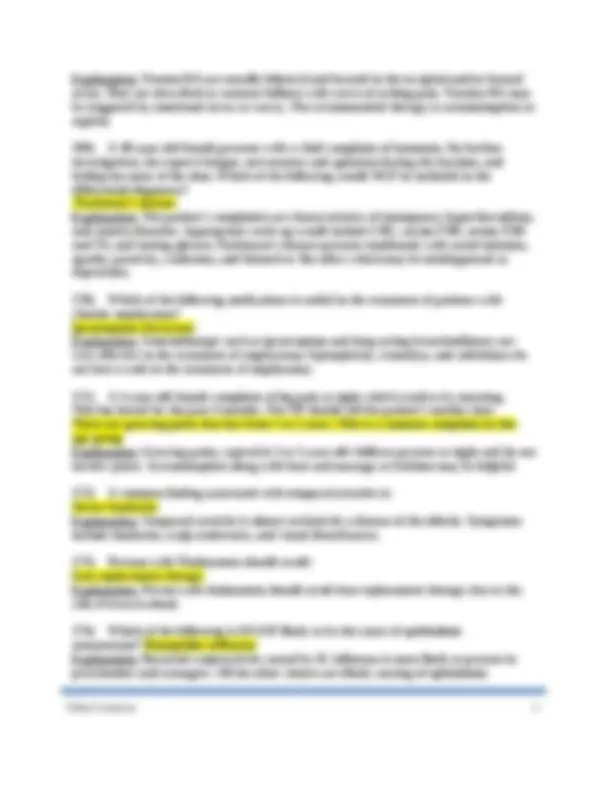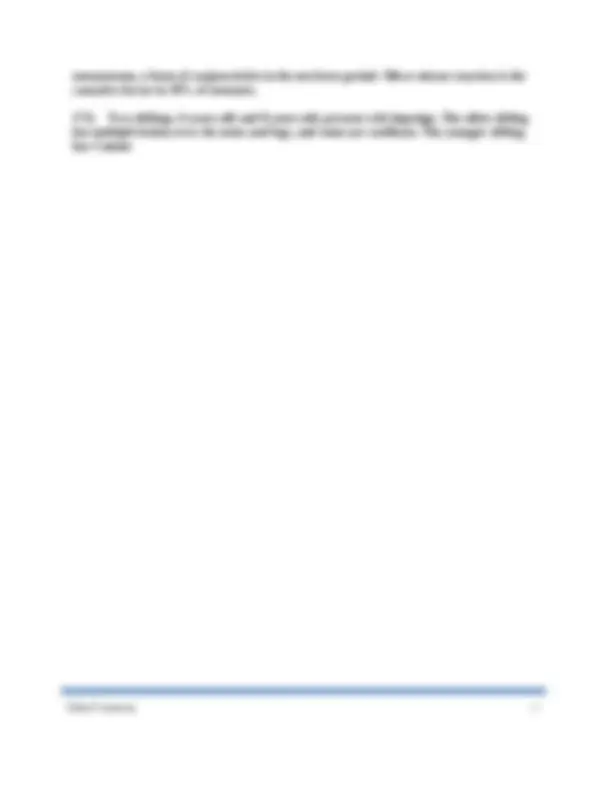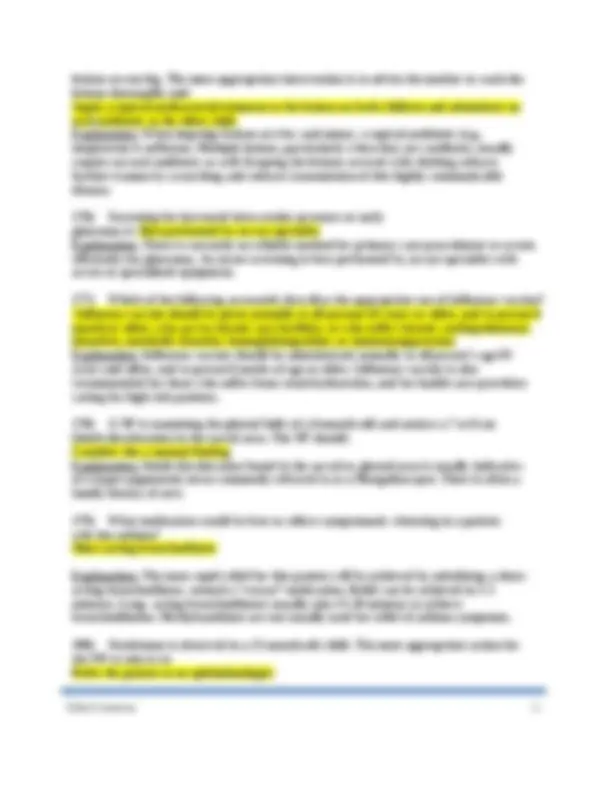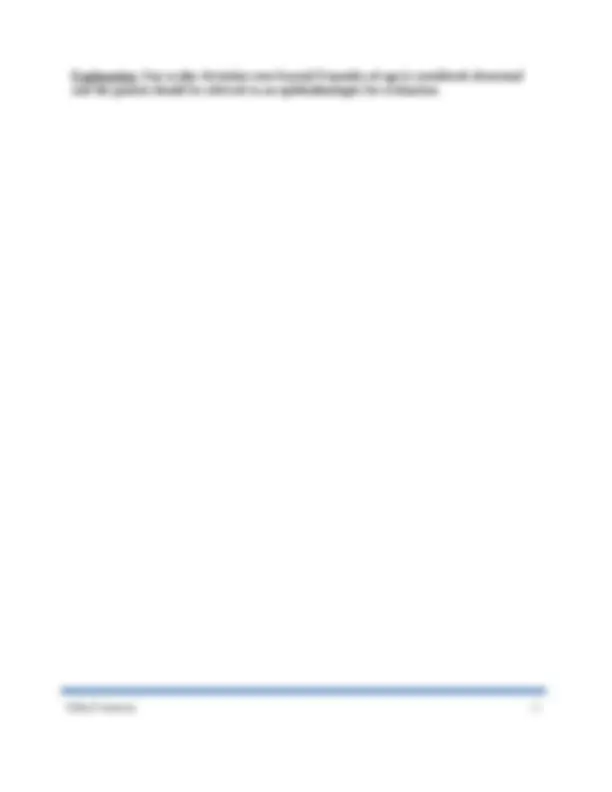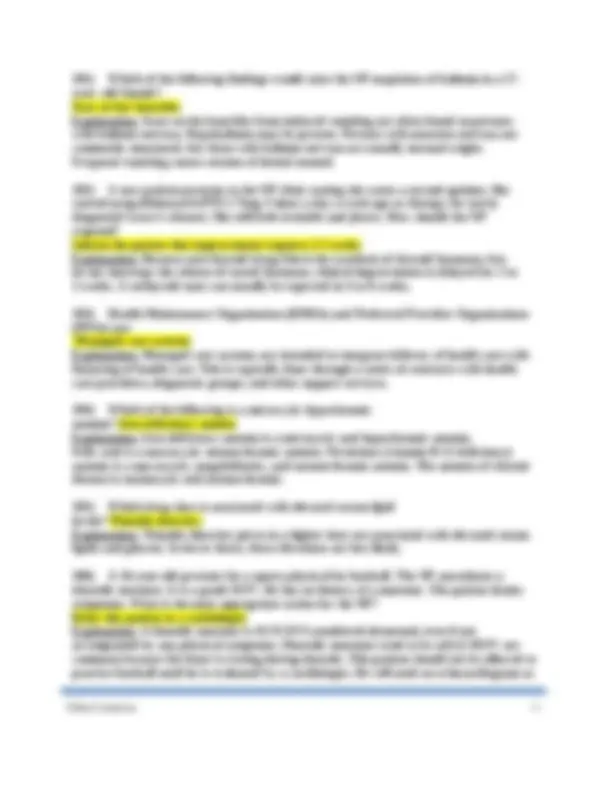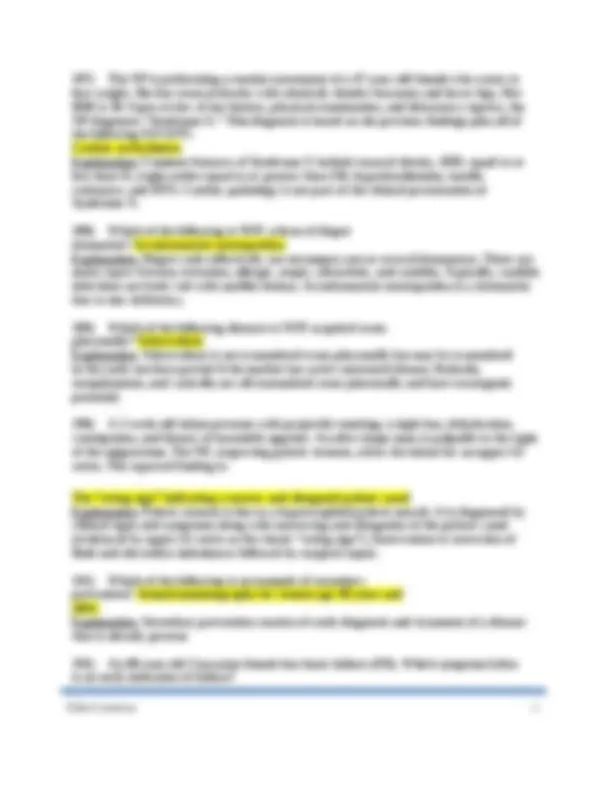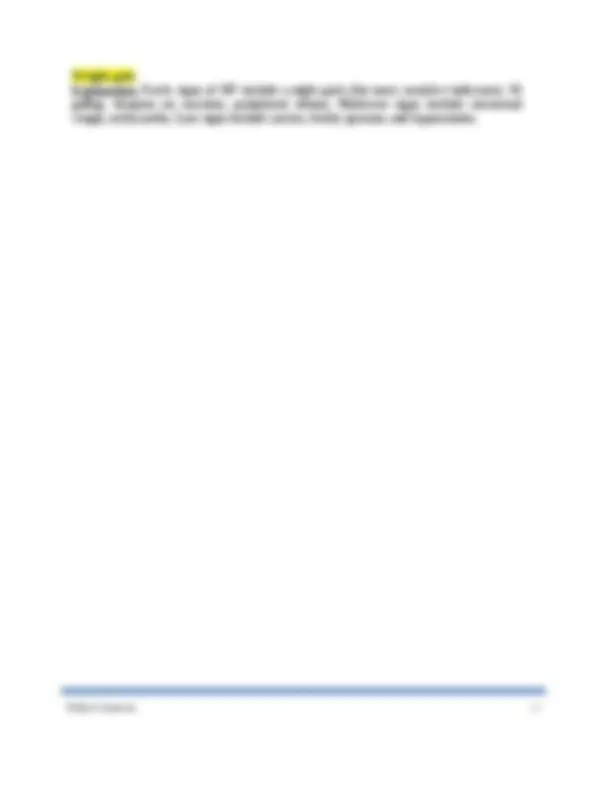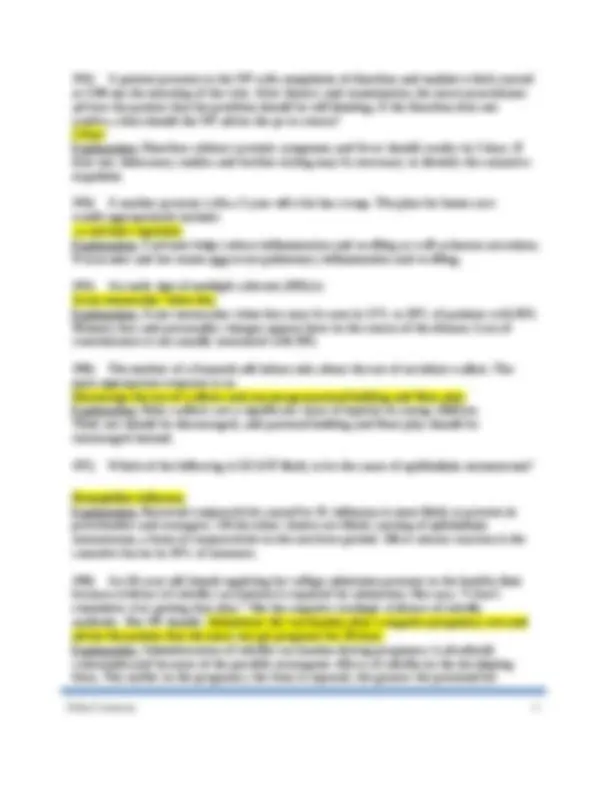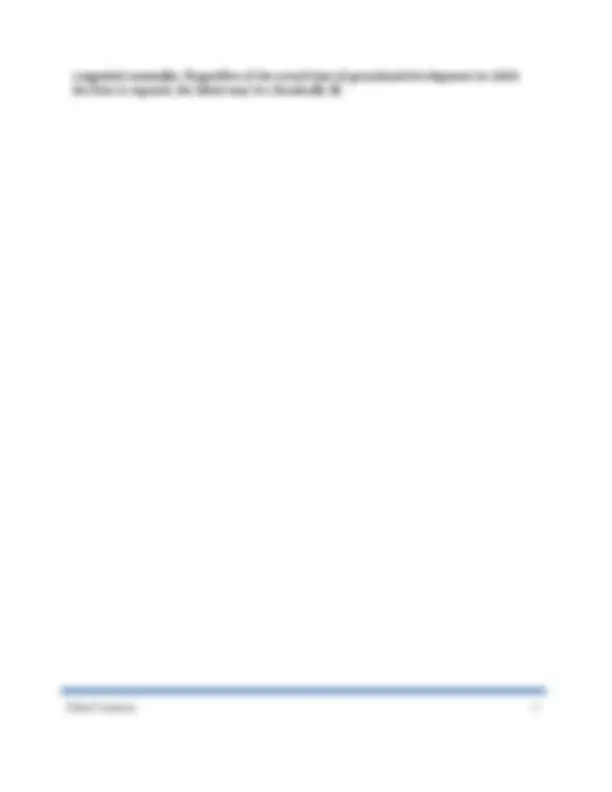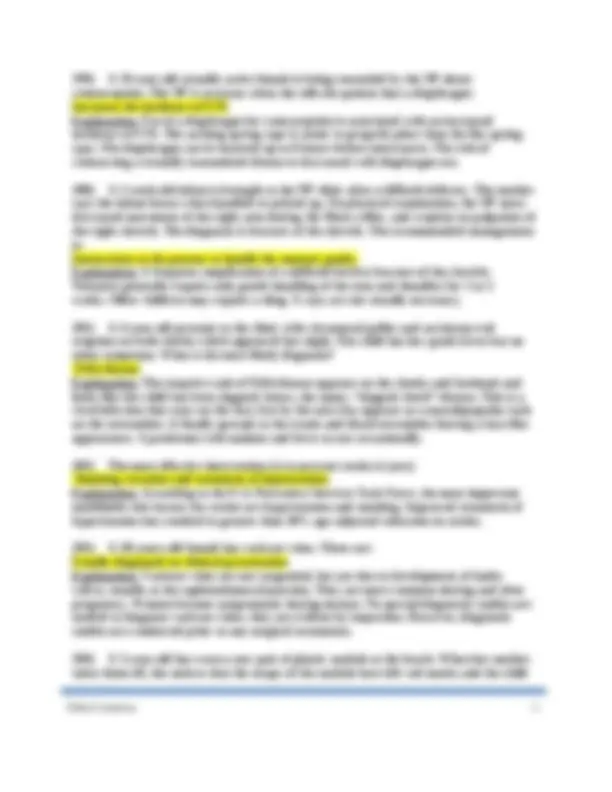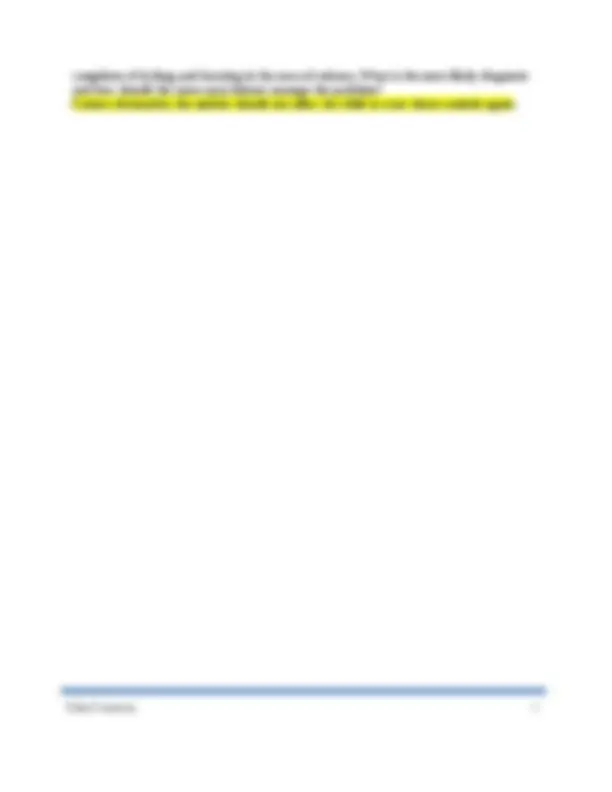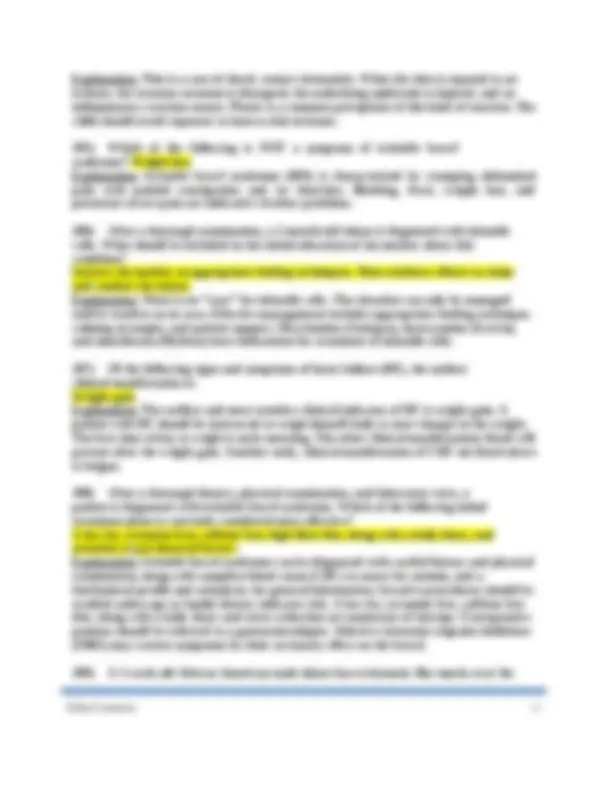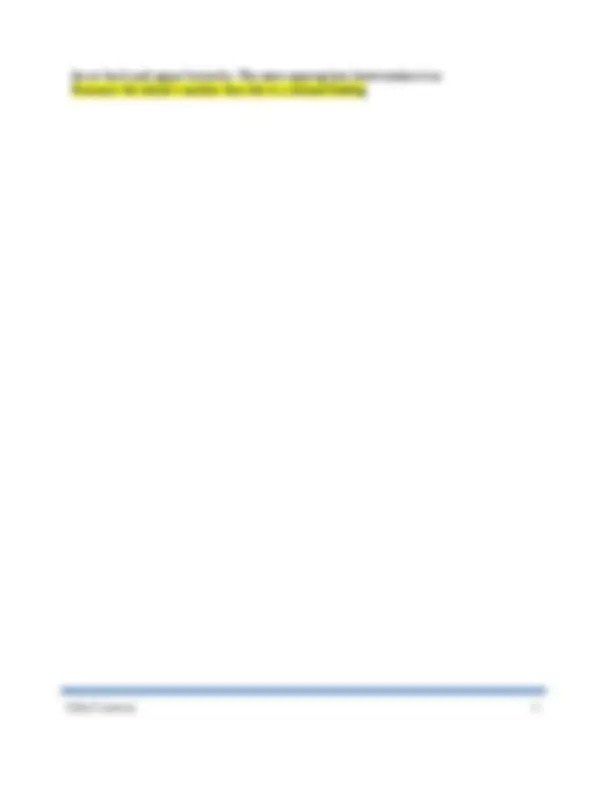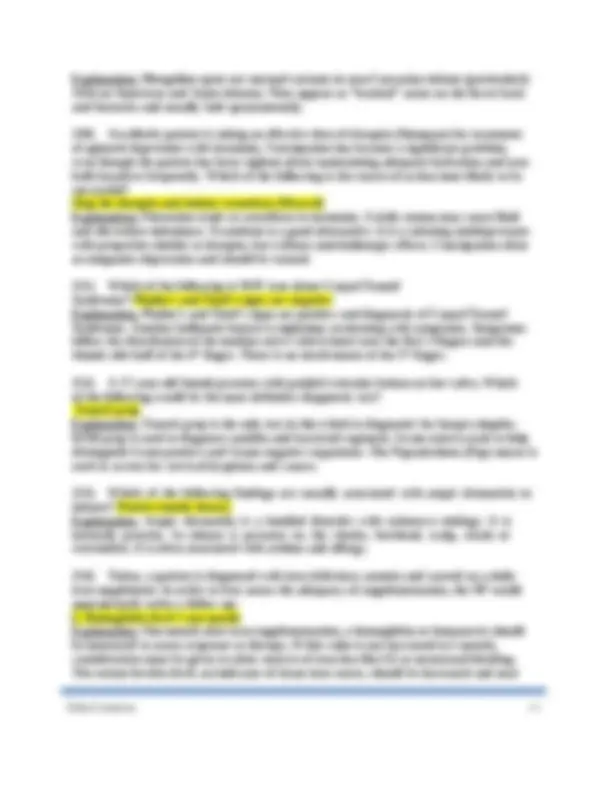Download NSG6440 Practicum IV Family Health. and more Exams Nursing in PDF only on Docsity!
NSG6440 Practicum IV
Family Health.
- A 15 years old high school student with a mild sore throat and low-grade fever that has persisted for about 3 weeks. She reports general malaise, fatigue, and loss of appetite. The NP suspects mononucleosis. Which of the following is the LEAST appropriate intervention? a. Palpate the lymph nodes and spleen b. Examine the posterior oropharynx for petechiae c. Obtain a CBC, throat culture, and heterophil antibody test. d. Obtain an urinalyses and serum for LFTs and amylase Explanation: mononucleosis is a symptomatic infection caused by the Epstein-Bar virus. Common is people 15-24 years of age. Common signs and symptoms following incubation period (1-2 months) include fatigue, chills, malaise, anorexia, white tonsillar exudates and lymphadenopathy or posterior cervical region. Splenomegaly can be present. A maculopapular or occasionally a petechial rash occurs in less than 15% of patients. A diagnosis is usually made using the Monospot. In addition, neutropenia and lymphocytosis are usually detected in the CBC.
- A 32 years old male patient complaint of urinary frequency and burning on urination for 3 days. Urinalyses reveals bacteriuria and positive nitrites. He denies any past hx. Of urinary tract infections. The initial treatment should be: a. trimethoprim-sulfamethoxazole (Bactrim, Sulfatrim) for 7-10 day b. ciprofloxacin (Cipro) for 3-5 days c. Trimethoprim-Sulfamethoxazole for 3 days d. 750 mg ciprofloxacin as a one-time dose Explanation: trimethoprim-sulfamethoxazole (TMPS) is usually n appropriate medication to treat urinary tract infections in most patients. In the case of community resistance to TMPS
20%^, another medication should be substituted. In men, the appropriate length of time is 7-10 days. Women may be treated for 3 days for uncomplicated UTI
- Which agent is most effective for the treatment of nodulocystic acne? a. Benzoyl peroxide (Benzac) b. Retinoic acid (Retin A)
c. Topical tetracycline d. Isotretinoin) Explanation: Isotretinoin (Accutane) is a systemic agent indicated for treatment with severe inflammatory acne. Guidelines for its use must be clearly understood by the patient. A woman of childbearing age must use an effective method of contraception because isotretinoin is teratogenic. There are many restrictions in prescribing this medication because of the teratogenic effects is given during pregnancy. Therefore, it is a pregnancy category X.
- An 18 y/o woman is taking a combined hormonal oral contraceptive. She should be instructed to use a backup method for the prevention of pregnancy a. Throughout the week of placebo pills
bellow the appropriate standard of care and hurts the patient. In this case the patient came with sings and symptoms indicating appendicitis and the NP failed to refer the patient..
- A NP has recently been hired to work in a fast track facility. The NP employer asked if she has “a problem prescribing medications for emergency contraception.” The NP replies affirmatively. This is: a. Grounds for dismissal
b. An ethical dilemma for the NP c. Illegal according to the standards of nursing d. Patient abandonment. Explanation: in this instance, the NP has a difference of opinion with her employer based on her religious or moral belief about providing emergency contraception. This situation is an example of an ethical dilemma. Failure to participate in the provision of care to the patient based on the NP’s beliefs is neither against the law nor a violation of the standards of practice
- A patient presents with pruritic lesions on both knees. There are visible silver scales. How Should this condition be managed? a. Topical antifungal cream or ointment b. Oral antibiotics c. Topical corticosteroids cream d. Topical anti-fungal/ steroid cream Explanation: Psoriasis is characterized by erythematous papules, as well as itchy, red, precisely defined plaques with silvery scales. Auspitz sings is another common finding. Topical agents containing tar and salicylic acid may be used. Topical steroids, such as betamethasone, may also be ordered.
- Antidepressant discontinuation syndrome is less likely if the patient a. Is male b. Is less than 35 y/o c. Has taken an SSRI with a short half life d.Gradually tapers SSRI use Explanation: Antidepressant discontinuation syndrome is most often seen in the primary care office in association with SSRI discontinuation, because SSRIs are the most commonly prescribed class of antidepressant medications. Interruption of treatment with an anti- depressant medication is sometimes associated with an antidepressant discontinuation syndrome; in early reports it was referred to as a “withdrawal reaction. Symptoms of antidepressant discontinuation syndrome can include flu-like symptoms, insomnia, nausea, imbalance, sensory disturbances, and hyperarousal. Tapering is recommended by experts.
- Patient with benign prostatic hyperplasia (BPH) should be taught to avoid which one of the following drug classes? a. Alpha adrenergic antagonist b. Anti-androgen agents c. Tricyclic antidepressant (TCA) d. Sulfonamides Explanation: tricyclic antidepressant should not be used by men with benign prostatic
a. What was if you did to make him angry? b. You must seek refuge immediately c. I am concerned about your safety d. I am going to call a shelter for you Explanation: The first step is to establish trust in the therapeutic relationship. without trust future collaboration, intervention and client outcome cannot be accomplished to facilitate appropriate and safe behavior. The experience of abuse is a traumatic psychological crisis that must be addressed as such. The healthcare providers must emphasize the fact that the victim has not done anything wrong and they must also emphasize the fact that the victim's life and the lives of their children can be in danger if the abuse is not addressed. It will not disappear with a lack of action. An order of protection against the perpetrator is often recommended.
- For which patient group does the US Preventive Services Task Force recommend routine screening for asymptomatic bacteriuria a. pregnant woman b. Children c. Patients with diabetes d. patients over the age of 70 Explanation: an increased incidence of bacteriuria is found in all the population listed. However, bacteriuria in pregnant women increases the mother…..Also increased is the risk of a pre-term delivery, which then increases perinatal and fetal morbidity and mortality. The recommended it….
- What diabetic complications result from hyperglycemia?
- Retinopathy
- Hypertension resistant to treatment
- Peripheral neuropathy
- Accelerated atherosclerosis a. 1,2, b. 2,3, c. 1,3, d. 1,2, explanation: Complications of untreated or uncontrolled hyperglycemia over a prolonged period of time include: Microvascular complications: Retinopathy, Nephropathy, Neuropathy Macrovascular complications: Coronary artery disease, Cerebrovascular disease, Peripheral vascular disease
- A 6 y/o presents w/ complaints of sore throat and fever for 2 days. He has multiple vesiculated ulcerations on his tonsils and uvula. There are no other remarkable findings. What is the most likely diagnosis?
a. Viral pharyngitis b. Herpangina c. Epiglottitis d. Tonsillitis
explanation given for them. The nurse practitioner questions the mother about abuse. She admits that her husband, the child’s father, beat the child. How should the nurse practitioner proceed? a. Inform the mother that the abuse must be reported to child protection authorities. b. Counsel the mother that if it happens again it will be reported to child protection service. c. Ask the child what she did to cause the punishment
d. Refer the family to the National Domestic Violence hotline. Explanation: An awareness of all the unique presentations of child abuse, subjective or objective, physical, sexual, or neglect, is essential for NPs. Objective findings, such as broken bones, burns, and bruises, may be as a result of an intentional injury from physical abuse or from an unintentional injury as a result of neglect. Both must be considered. Repeated visits to the emergency department, frequent or suspicious injuries, or bilateral or multiple healing fractures are often indicators of physical abuse. Once the diagnosis of child abuse has been made, the primary role of the NP is to ensure the child is safe. If the NP suspect that a child is undergoing abuse, it’s critical to report it—and to continue reporting each separate incidence if it continues to recur.
- A 1-month-old presents with reported recurrent diarrhea, screaming, and drawing up of the legs followed by periods of lethargy. On physical examination, a “sausage-like” mass in the upper right quadrant of the distended abdomen. Which of the following is the most likely diagnosis? a. Intussusception b. Volvulus c. Crohn’s disease d. Foreign body in the GI tract explanation: Intussusception is one of the most common causes of abdominal obstruction in children prior 2 years of age; is best described as a portion of the intestine which telescopes into a more distal intestinal segment. The classic triad of intussusception include crampy (intermittent, also known as colicky) abdominal pain, vomiting, and bloody stools. The patient may pull up his knees with crying. The patient may develop vomiting with bilious emesis. Progressive lethargy/altered level of consciousness and pallor is common. The etiology of this lethargic presentation is not known, but it tends to occur in younger infants. As intussusception progresses, a palpable, sausage-shape mass may develop. Some hypothesize that this is due to release of endogenous opioids or endotoxins released from ischemic bowel. Intussusception in a child presenting with lethargy is often difficult to diagnose since other causes of lethargy such as dehydration, hypoglycemia, sepsis, toxic ingestion, post- ictal state, etc., must also be considered. Ultrasound is the preferred diagnostic test. Enemas is considered the first line of treatment prior surgery. Volvulus occurs more frequently in middle-aged and elderly men. Cronos’s is most often diagnosed between 13 – 30 years of age.
- A middle-aged female complains of insomnia, night sweats, feeling intensely hot, emotional lability, extreme nervousness and impatience. The LEAST likely cause of her symptoms is a. Thyrotoxicosis b. Menopausal vasomotor instability c. Alcohol or another drug withdrawal d. New onset type 2
be caused by thyroxine excess, menopausal instability, or withdrawal from alcohol or other drugs of addiction.
- Which of the following indicated need for further evaluation? a. A 7 y/o girl with vaginal bleeding b. A 7 years old girl with no true pubic hair c. A 12 years old boy with sparse, slightly pigmented pubic hair d. A 12-year-old girl with breast buds explanation: In newborn girls, withdrawal bleeding may occur as a normal response to maternal estrogen leaving the infant’s uterine lining. Vaginal bleeding after the first few weeks of life and before puberty is considered abnormal. Early vaginal bleeding can indicate trauma, foreign bodies (toilet paper is the most common), vulvovaginitis, hemangiomas, benign polyps, precocious puberty, or sexual abuse.
- A young couple is being seen by the NP for preconception counseling. They express a wish for pregnancy within the next 3 month and are very eager to know what they can do now to “make the baby as healthy as possible”. Which of the following should the NP encourage to decrease the chance of neural tube defect in the fetus? a. Maternal alpha-fetoprotein level b. Folic acid 0.4 mg daily c. Rubella vaccine today d. Vitamin E 400 IU daily Explanation: Supplementation with folic acid decreases the development of neural tube defects, such as spina bifida and anencephaly. Folic acid plays an essential role in neural tube closure. Neural tube development/closure takes place in the fist 4 weeks of embryonic life (6 weeks’ gestation). U.S. Public Health Service and the CDC recommend that all women of childbearing age consume 0.4 mg of folic acid daily to prevent tube defects.
- A patient with a past history of documented coronary arterial blockage less than 70% complains of chest pain several time p…. which is relived with nitroglycerin. Which is the most appropriate initial action for the NP? a. Refer to a cardiologist as soon as possible b. Prescribe long-acting nitroglycerin c. Order treadmill stress test d. Prescribe an ACE inhibitor and re-evaluate in 24 to 48 hours Explanation: The patient has at least a 70% occlusion of a major coronary artery. For a patient to be considered for CABG, the coronary arteries to be bypassed must have approximately a 70% occlusion (60% if in the left main coronary artery).
- A 3 y/o has enlarged, warm, tender cervical lymph nodes, indicating: a. Infection proximal to the nodes b. A possible cancer diagnosis c. Shorty nodes, a common normal variant in children
d. An infectious process distal to the nodes explanation: size of lymph nodes is important. Nodes > 1 cm are significant and should be asses carefully. Nodes > 5 cm are almost always neoplastic. Tenderness of a node usually suggest
a. An audible or palpated “click” is positive for a torn meniscus b. A various stress is applied to the flexed knee c. The straight leg is internally rotated with the patient supine and flat d. The knee is grasped with the examiner’s fingers placed laterally. Explanation: Mac Murray’s test is conducted while the patient is in the supine position. The NP places the distal hand on the foot and raises the knee slowly, keeping the foot and knee externally
rotated with the proximal hand resting on the join line. The knee is flexed and then quickly straightened. If an audible or palpable click occurs during the this test, the outcome is positive for medial meniscal injury.
- A 20 y/o male patient complains of “scrotal swelling”. He states his scrotum feels heavy but denies pain. On examination, the NP notes transillumination of the scrotum. What is the most likely diagnosis? a. Hydrocele b. Orchitis c. Testicular torsion d. Indirect inguinal hernia Explanation: Hydrocele is common in newborns and usually disappears without treatment within the first year. Older men can develop hydroceles, sometimes due to inflammation or injury. Hydroceles are usually painless, but may become large and inconvenient. An ultrasound may be needed to diagnose the condition.
- A 15 y/o male has a hx of cryptorchidism which was surgically repaired. Because of this information, it is essential for the NP to teach him about a. Testicular self-examination b. Protection of the testes during sports activities c. Risk of testicular torsion d. Practicing safer sex Explanation: Cryptorchidism, even with surgical repair, is associated with increased risk for testicular cancer.
- A pt. present with classic symptoms of gastroesophageal reflux diseases’ (GERD). He is instructed in lifestyle modification, and drug initialed. Two month later, he returns and report that he still has symptoms. The next steps are to. a) Refer for surgical interventions such as partial or complete fundoplication. b) Refer for endoscopy, namometry, and/or PH testing c) Repeat the 8*-week course of drug therapy while continuing lifestyles modifications. d) Review proper proton pump inhibitor dosing time and adherence with the patient. Explanation: poor adherence is an importance cause of inadequate acid suppression and refractory GERD. Determining adherence to proton pump inhibitor (PPI) therapy and superficially timing in relation to meals, should be sought first alarm features such as iron deficiency anemia, unexplained weight loss, and persistent vomiting would precipitate the need for further diagnostic testing. Diagnostic testing procedures should proceed any surgical intervention like fundoplication.
- A 51 –year- old post-menopausal female, request guidance regarding osteoporosis risk. The NP would be correct to recommend all of the following EXCEPT a. Moderate weight bearing exercise 3 times per week b. 1200 – 1500 mg calcium daily c. Avoidance of alcoholic
Explanation: the recommended calcium intake is 1,200 mg – 1500 mg a day. Regular weight- bearing and muscle-strengthening exercise reduce the risk of falls and fractures. Moderate alcohol intake has no known negative effect on bone and may even be associated with slightly higher bone density and lower risk of fracture in postmenopausal women. However, alcohol intake of more than two drinks per day for women or three drinks a day for men may be detrimental to bone health, increases the risk of falling and requires further evaluation for possible alcoholism. In addition, Risk factors for osteoporosis include age greater than 65, white or Asian ethnicity, cigarette smoking, inactive lifestyle, low weight and postmenopausal estrogen deficiency including premature menopause.
- According to Erickson, the developmental task of the elderly adult is: a. Intimacy VS isolation b. Ego integrity VS despair c. Industry VS self-doubt d. Trust Vs mistrust explanation:
- Moderate weight loss, particularly of visceral adipose tissue in patients with type 2 diabetes mellitus may have all of the following beneficial effects EXCEPT: a. Improved insulin sensitivity b. Increased glucose uptake and utilization by the cells c. Increase lean muscle mass’
d. Improved lipid profile Explanation: Regular, consistent exercise is an essential part of diabetes and prediabetes management. The ADA recommends that people with diabetes perform at least 30 minutes, 5

